Fujitsu Client Computing WB0029 LIFEBOOK T SERIES W/ WLL4070 11ABG WLAN & BT User Manual Appendix I 1
Fujitsu Limited LIFEBOOK T SERIES W/ WLL4070 11ABG WLAN & BT Appendix I 1
Contents
- 1. User manual part 1
- 2. User manual part 2
- 3. User manual part 3
- 4. User Manual part 1
User Manual part 1

FCC ID: EJE-WB0029 (IC: 337J-WB0029) Report No. M050510_Cert_WLL4070_11abg_NII_BT
This document must not be copied or reproduced, except in full without the written permission of
the Manager, EMC Technologies Pty Ltd. The certificate on page 3 may be reproduced in full.
www.emctech.com.au
APPENDIX I
USER MANUAL FINAL DRAFT (PART 1)
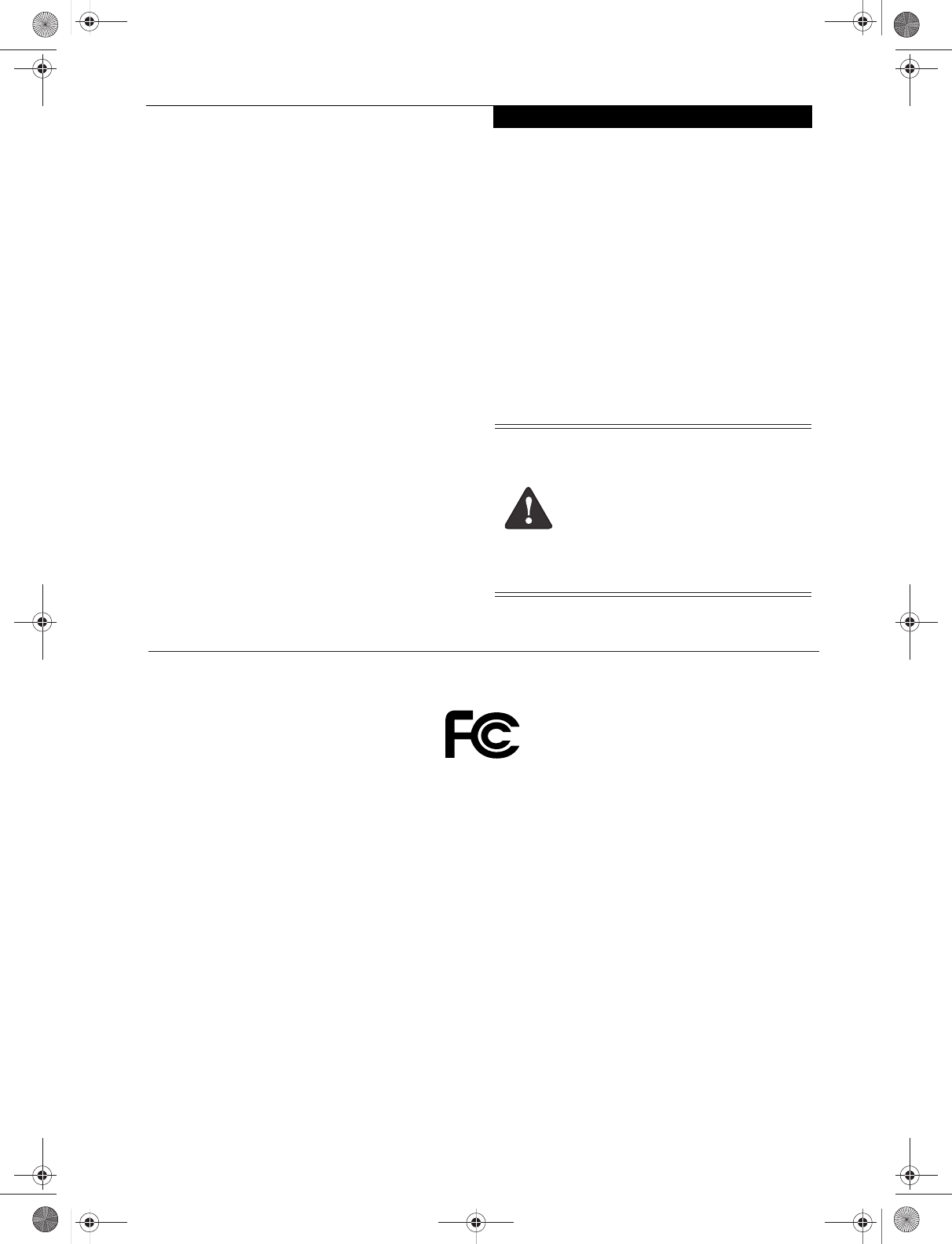
Copyright
Copyright & Trademark Information
Fujitsu Computer Systems Corporation has made every
effort to ensure the accuracy and completeness of this
document. However, as ongoing development efforts are
continually improving the capabilities of our products, we
cannot guarantee the accuracy of the contents of this
document. We disclaim liability for errors, omissions, or
future changes.
Fujitsu, the Fujitsu logo, and LifeBook are registered
trademarks of Fujitsu Limited.
MS, MS-DOS, and Windows are either registered
trademarks or trademarks of Microsoft Corporation in the
United States and/or other countries.
PCMCIA is a trademark of the Personal Computer
Memory Card International Association.
Intel and Pentium are trademarks or registered trademarks
of Intel Corporation or its subsidiaries in the United States
and other countries.
Bluetooth is a registered trademark of Bluetooth SIG, Inc.
Adobe, Acrobat, and Acrobat Reader are either a registered
trademarks or trademarks of Adobe Systems Incorporated
in the United States and/or other countries.
All other trademarks mentioned herein are the property
of their respective owners.
© Copyright 2004 Fujitsu Computer Systems Corpora-
tion. All rights reserved. No part of this publication may
be copied, reproduced, or translated, without prior
written consent of Fujitsu Computer Systems Corpora-
tion. No part of this publication may be stored or trans-
mitted in any electronic form without the written
consent of Fujitsu Computer Systems Corporation.
B6FH-3071-01EN-00
Warning
Handling the cord on this product or cords
associated with accessories sold with this
product, will expose you to lead, a
chemical known to the State of California
to cause birth defects or other
reproductive harm.
Wash hands after handling.
DECLARATION OF CONFORMITY
according to FCC Part 15
Responsible Party Name: Fujitsu Computer Systems Corporation
Address: 1250 E. Arques Avenue, MS 122
Sunnyvale, CA 94085
Telephone: (408) 746-6000
Declares that product: Model Configuration:
LifeBook T4020 Tablet PC
LifeBook T4020D Tablet PC
Complies with Part 15 of the FCC Rules.
This device complies with Part 15 of the FCC rules. Operations are subject to the following two conditions:
(1) This device must not be allowed to cause harmful interference, (2) This device must accept any interference
received, including interference that may cause undesired operation.
T Series.book Page 1 Wednesday, July 28, 2004 3:35 PM
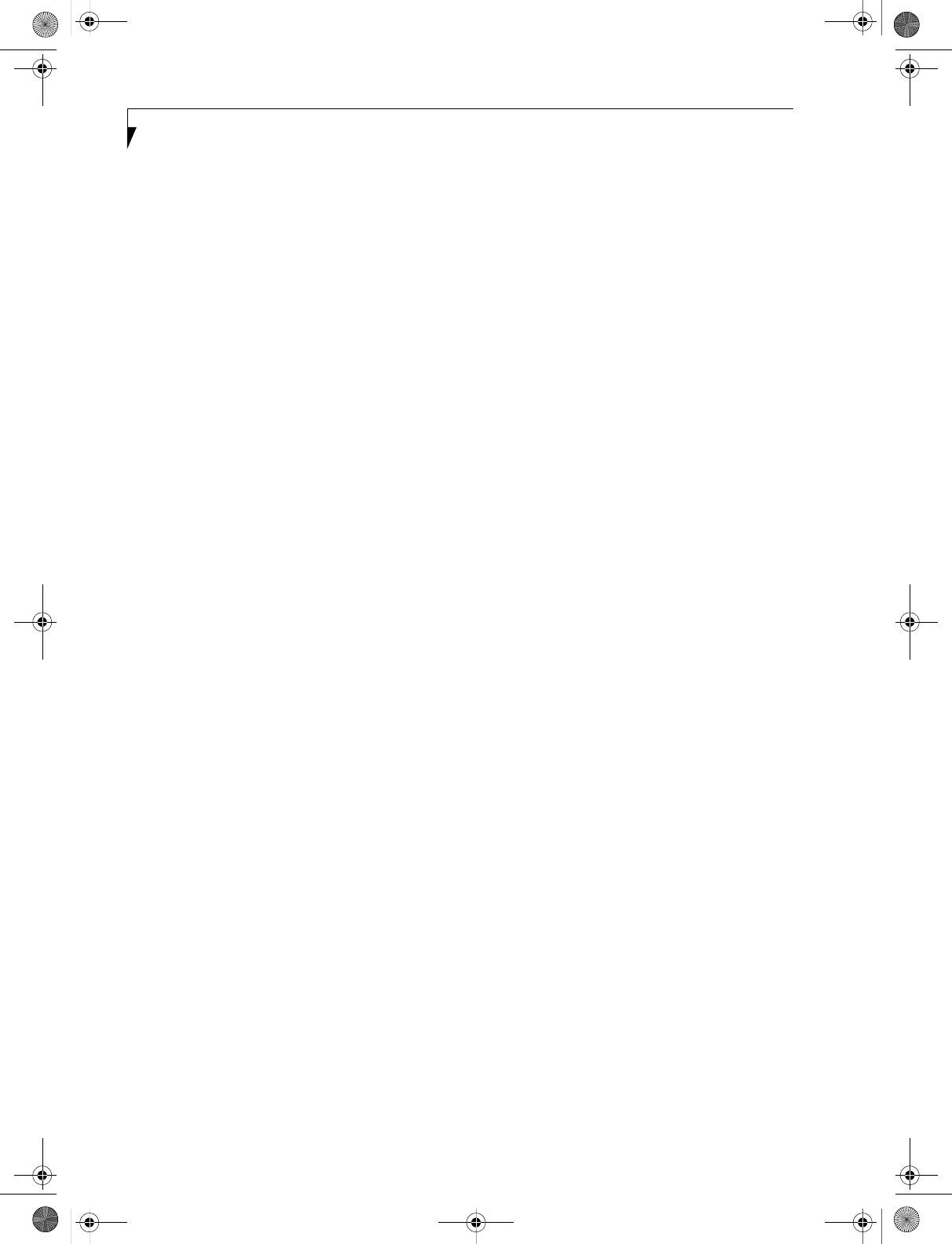
LifeBook T Series Tablet PC
T Series.book Page 2 Wednesday, July 28, 2004 3:35 PM
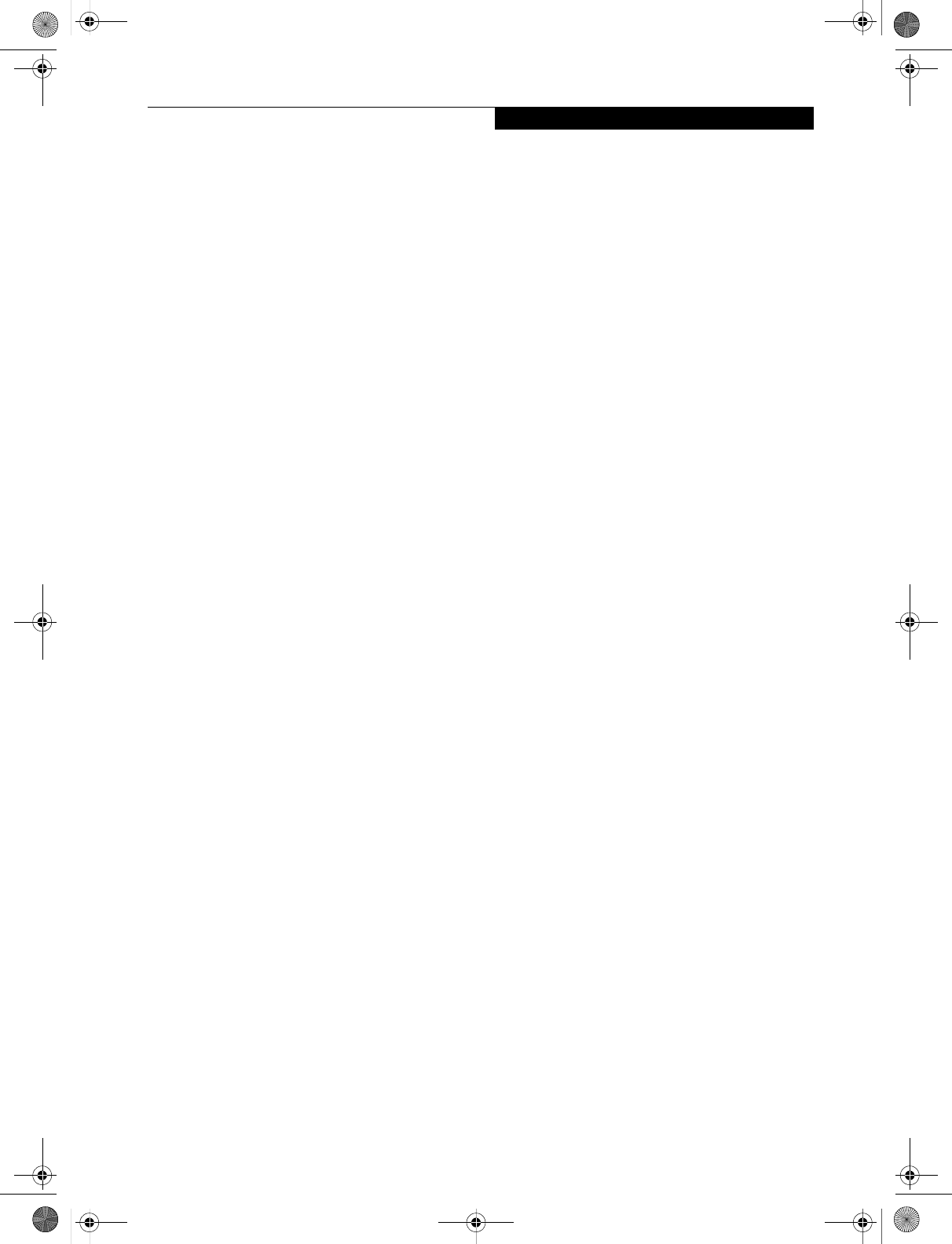
Table of Contents
Fujitsu LifeBook® T Series Tablet PC
Table of Contents
1
PREFACE
Preface
About This Guide . . . . . . . . . . . . . . . . . . . . . . . . .3
Fujitsu Contact Information . . . . . . . . . . . . . . . . .3
Warranty . . . . . . . . . . . . . . . . . . . . . . . . . . . . . . .3
2
GETTING TO KNOW
YOUR TABLET PC
Overview
Unpacking . . . . . . . . . . . . . . . . . . . . . . . . . . . . . .7
Optional Accessories . . . . . . . . . . . . . . . . . . . . . .8
Locating the Controls and Connectors
Top and Front Components . . . . . . . . . . . . . . . .10
Left-Side Panel Components . . . . . . . . . . . . . . .11
Right-Side Panel Components . . . . . . . . . . . . . .12
Rear Panel Components . . . . . . . . . . . . . . . . . . .13
Bottom Components . . . . . . . . . . . . . . . . . . . . .14
Status Indicator Panel
Power Indicator . . . . . . . . . . . . . . . . . . . . . . . . .15
AC Adapter Indicator . . . . . . . . . . . . . . . . . . . . .15
Battery Level Indicators . . . . . . . . . . . . . . . . . . .15
Battery Charging Indicator . . . . . . . . . . . . . . . . .16
Hard Drive Access Indicator . . . . . . . . . . . . . . . .16
NumLk Indicator. . . . . . . . . . . . . . . . . . . . . . . . .16
CapsLock Indicator. . . . . . . . . . . . . . . . . . . . . . .16
ScrLk Indicator . . . . . . . . . . . . . . . . . . . . . . . . . .16
Security Indicator . . . . . . . . . . . . . . . . . . . . . . . .16
Display Panel
Opening the Display Panel . . . . . . . . . . . . . . . . .17
Using the System as a Tablet . . . . . . . . . . . . . . .17
Adjusting Display Panel Brightness . . . . . . . . . . .18
Keyboard
Using the Keyboard . . . . . . . . . . . . . . . . . . . . . .19
Numeric Keypad. . . . . . . . . . . . . . . . . . . . . . . . .19
Windows Keys . . . . . . . . . . . . . . . . . . . . . . . . . .19
Cursor Keys . . . . . . . . . . . . . . . . . . . . . . . . . . . .20
Function Keys. . . . . . . . . . . . . . . . . . . . . . . . . . .20
LifeBook Security/Tablet PC Buttons
Changing Tablet PC Button Functions . . . . . . . .22
Setting up LifeBook Security Panel . . . . . . . . . . .22
Passwords . . . . . . . . . . . . . . . . . . . . . . . . . . . . .22
Using Your LifeBook Security Panel . . . . . . . . . .23
Precautions. . . . . . . . . . . . . . . . . . . . . . . . . . . . .23
Uninstalling the Security Panel Application . . . . .24
Touchpad Pointing Device
Clicking . . . . . . . . . . . . . . . . . . . . . . . . . . . . . . .25
Double-Clicking . . . . . . . . . . . . . . . . . . . . . . . . .25
Dragging . . . . . . . . . . . . . . . . . . . . . . . . . . . . . .26
Scrolling . . . . . . . . . . . . . . . . . . . . . . . . . . . . . . .26
Touchpad Control Adjustment . . . . . . . . . . . . . .26
Pen and Active Digitizer
Using the Pen. . . . . . . . . . . . . . . . . . . . . . . . . . .27
Calibrating the Pen. . . . . . . . . . . . . . . . . . . . . . .27
Replacing the Pen Tip. . . . . . . . . . . . . . . . . . . . .28
Using the Active Digitizer . . . . . . . . . . . . . . . . . .28
Volume Control
Controlling the Volume . . . . . . . . . . . . . . . . . . .29
T Series.book Page 3 Wednesday, July 28, 2004 3:35 PM
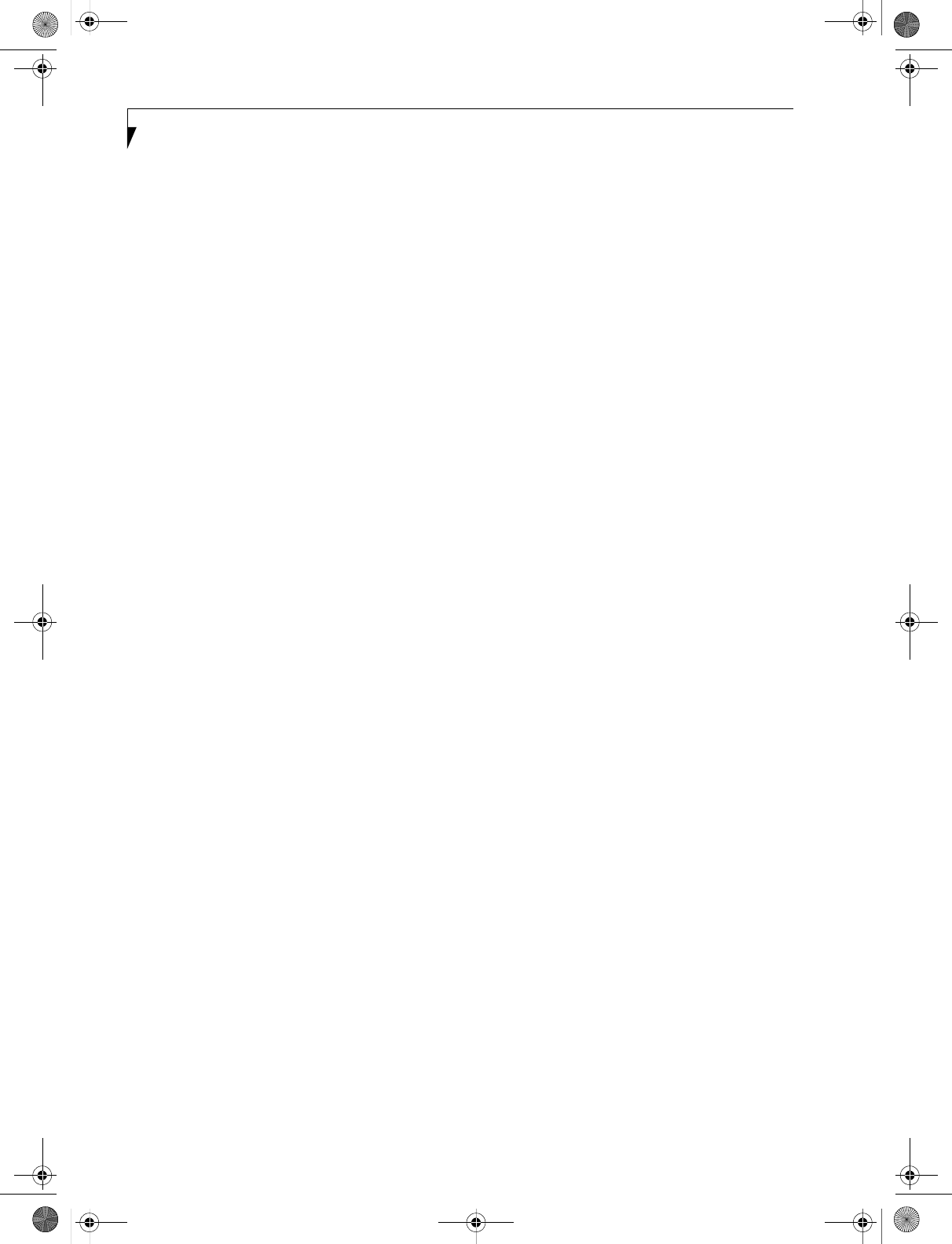
LifeBook T Series Tablet PC
3
USING YOUR TABLET PC
Power Sources
Connecting the Power Adapters. . . . . . . . . . . . . 33
Starting Your Tablet PC
Power On . . . . . . . . . . . . . . . . . . . . . . . . . . . . . 34
Boot Sequence. . . . . . . . . . . . . . . . . . . . . . . . . . 34
BIOS Setup Utility . . . . . . . . . . . . . . . . . . . . . . . 34
Booting the System . . . . . . . . . . . . . . . . . . . . . . 35
Activating Additional Utilities . . . . . . . . . . . . . . . 35
Registering Your LifeBook T Series Tablet PC . . . 35
Power Management
Suspend/Resume Button . . . . . . . . . . . . . . . . . . 36
Standby Mode . . . . . . . . . . . . . . . . . . . . . . . . . . 36
Hibernate Mode. . . . . . . . . . . . . . . . . . . . . . . . . 37
Display Timeout . . . . . . . . . . . . . . . . . . . . . . . . . 37
Hard Disk Timeout . . . . . . . . . . . . . . . . . . . . . . . 37
Windows Power Management. . . . . . . . . . . . . . 37
Restarting the System. . . . . . . . . . . . . . . . . . . . . 37
Power Off . . . . . . . . . . . . . . . . . . . . . . . . . . . . . 38
4
USER-INSTALLABLE FEATURES
Lithium ion Battery
Recharging the Battery. . . . . . . . . . . . . . . . . . . . 41
Replacing the Battery. . . . . . . . . . . . . . . . . . . . . 42
Memory Upgrade Module
Installing Memory Upgrade Modules . . . . . . . . . 43
To Remove a Memory Upgrade Module . . . . . . 43
Checking the Memory Capacity. . . . . . . . . . . . . 44
PC Cards
Installing PC Cards . . . . . . . . . . . . . . . . . . . . . . . 45
Removing PC Cards . . . . . . . . . . . . . . . . . . . . . . 45
Smart Card Reader. . . . . . . . . . . . . . . . . . . . . . . 45
Port Replicator
Rear Panel Components. . . . . . . . . . . . . . . . . . . 46
Front Panel Components . . . . . . . . . . . . . . . . . . 47
Attaching the Port Replicator. . . . . . . . . . . . . . . 47
Detaching the Port Replicator . . . . . . . . . . . . . . 47
Device Ports
Modem (RJ-11) Jack . . . . . . . . . . . . . . . . . . . . . 48
Internal LAN (RJ-45) jack. . . . . . . . . . . . . . . . . . 48
Docking Port . . . . . . . . . . . . . . . . . . . . . . . . . . . 48
Universal Serial Bus Ports . . . . . . . . . . . . . . . . . . 48
Infrared Port . . . . . . . . . . . . . . . . . . . . . . . . . . . 48
Microphone Jack . . . . . . . . . . . . . . . . . . . . . . . . 49
Headphone Jack . . . . . . . . . . . . . . . . . . . . . . . . 49
External Monitor Port . . . . . . . . . . . . . . . . . . . . 49
5
TROUBLESHOOTING
Troubleshooting
Identifying the Problem . . . . . . . . . . . . . . . . . . . 53
Specific Problems. . . . . . . . . . . . . . . . . . . . . . . . 53
Troubleshooting Table . . . . . . . . . . . . . . . . . . . . 54
Power On Self Test Messages . . . . . . . . . . . . . . 61
Modem Result Codes. . . . . . . . . . . . . . . . . . . . . 62
Restoring Your Software
Drive Image Special Edition (DISE) . . . . . . . . . . . 63
6
CARING FOR YOUR TABLET PC
Care and Maintenance
Keyboard. . . . . . . . . . . . . . . . . . . . . . . . . . . . . . 68
Batteries. . . . . . . . . . . . . . . . . . . . . . . . . . . . . . . 68
Optional Floppy Disk Drive and Floppy Disks. . . 68
Optional CD Drive and CDs. . . . . . . . . . . . . . . . 68
PC Cards . . . . . . . . . . . . . . . . . . . . . . . . . . . . . . 69
T Series.book Page 4 Wednesday, July 28, 2004 3:35 PM
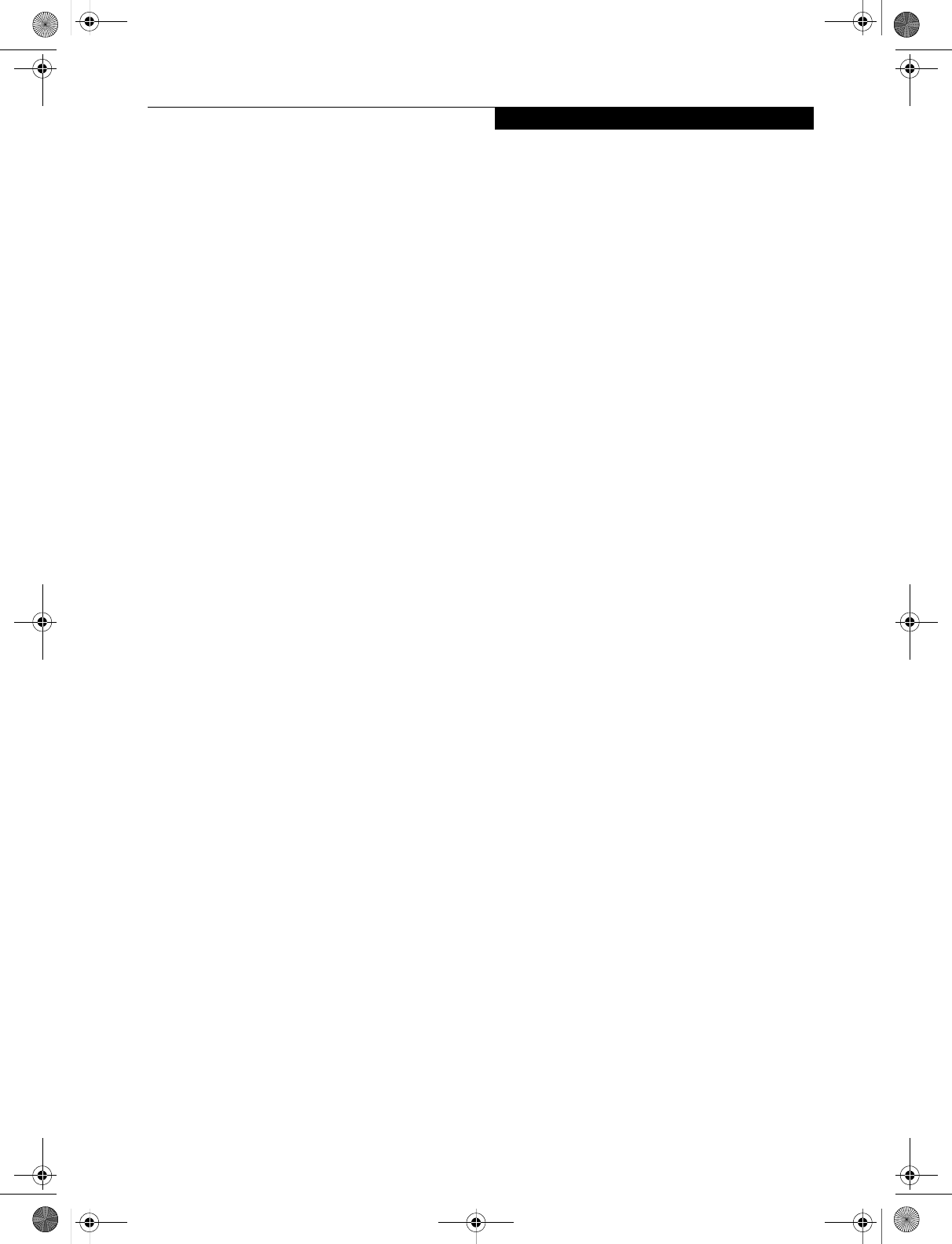
Table of Contents
7
SPECIFICATIO NS
Specifications
Configuration Label . . . . . . . . . . . . . . . . . . . . . . 73
Physical Specifications . . . . . . . . . . . . . . . . . . . . 73
Processing Specifications . . . . . . . . . . . . . . . . . . 73
Memory/Storage Specifications . . . . . . . . . . . . . 73
Display Specifications . . . . . . . . . . . . . . . . . . . . . 73
Interface Specifications. . . . . . . . . . . . . . . . . . . . 73
Power Specifications. . . . . . . . . . . . . . . . . . . . . . 74
Environmental Specifications . . . . . . . . . . . . . . . 74
Agency Approval Specifications . . . . . . . . . . . . . 74
Additional Specifications. . . . . . . . . . . . . . . . . . . 74
Regulatory Information . . . . . . . . . . . . . . . . . . . 75
8
GLO SSARY
Glossary . . . . . . . . . . . . . . . . . . . . . . . . . . . . . . . 81
APPENDIX: INTEGRATED
W IRELESS LAN USER’S GUIDE
Before Using the W ireless LAN
W ireless LAN M odes Using this Device. . . . . . . . 90
W ireless Network Considerations . . . . . . . . . . . . 91
Deactivating the W LAN Device . . . . . . . . . . . . . 92
Activating the W LAN Device . . . . . . . . . . . . . . . 92
Configuration of the W LAN Device
Flow of O perations. . . . . . . . . . . . . . . . . . . . . . . 93
Configuration Using W ireless
Zero Configuration Tool. . . . . . . . . . . . . . . . 93
Configuration Using Intel PRO Set Software . . . . 94
Configuration Using Atheros
Client Utility Software . . . . . . . . . . . . . . . . . 95
Connection to the network. . . . . . . . . . . . . . . . . 97
Troubleshooting the W LAN
Troubleshooting . . . . . . . . . . . . . . . . . . . . . . . . 101
Wireless LAN Glossary
Glossary . . . . . . . . . . . . . . . . . . . . . . . . . . . . . . 102
IP address information
Additional Information . . . . . . . . . . . . . . . . . . . 103
W LAN Specifications
Specification . . . . . . . . . . . . . . . . . . . . . . . . . . . 104
T Series.book Page 5 Wednesday, July 28, 2004 3:35 PM
Using the Bluetooth Device
W hat is Bluetooth . . . . . . . . . . . . . . . . . . . . . . 109
W here to Find Information About Bluetooth . . 109
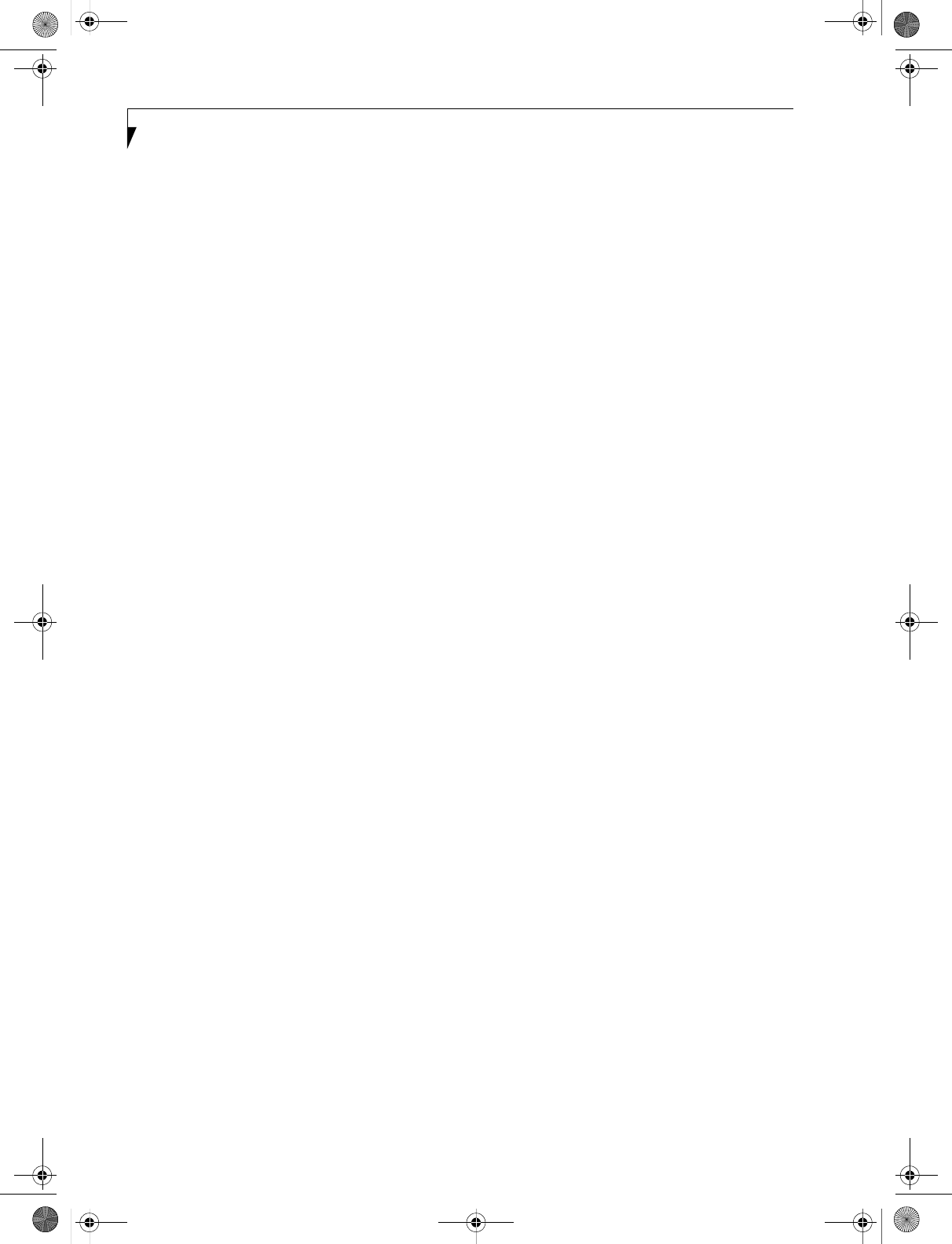
LifeBook T Series Tablet PC
T Series.book Page 6 Wednesday, July 28, 2004 3:35 PM

1
1
Preface
T Series.book Page 1 Wednesday, July 28, 2004 3:35 PM
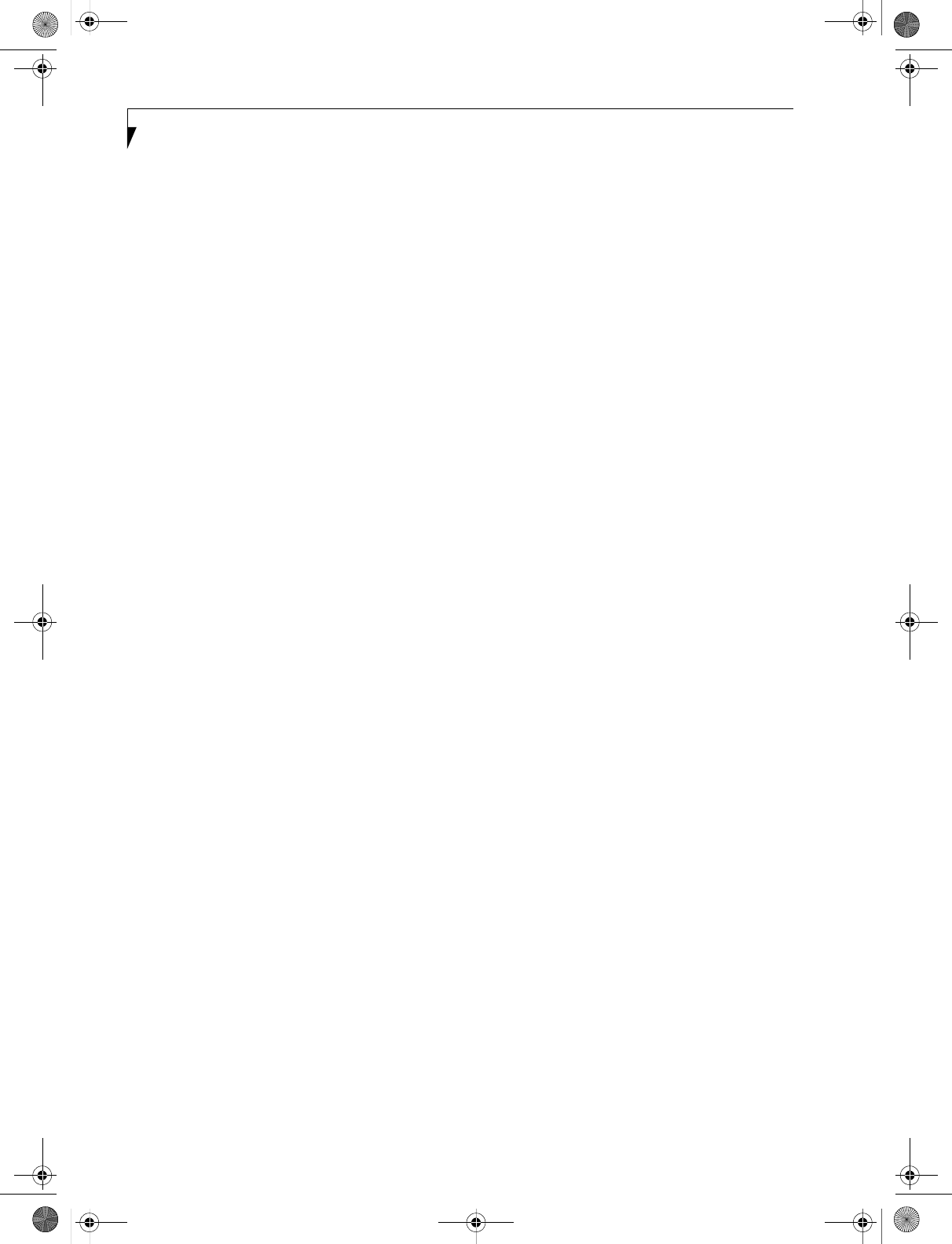
2
LifeBook T Series Tablet PC
T Series.book Page 2 Wednesday, July 28, 2004 3:35 PM
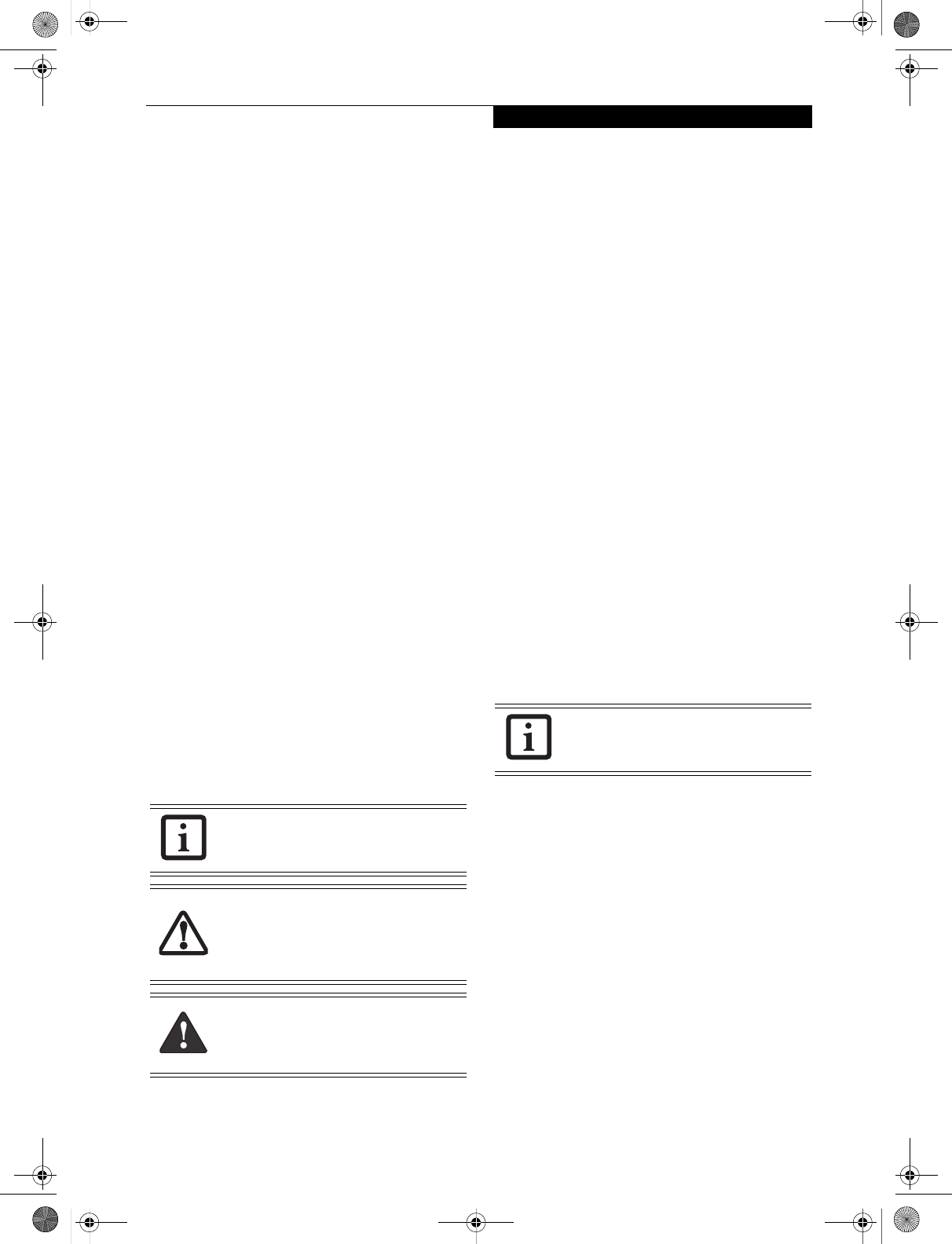
3
Preface
Preface
ABOUT THIS GUIDE
The LifeBook® T Series Tablet PC from Fujitsu
Computer Systems Corporation is a powerful convert-
ible computer. It can be used either as a standard note-
book using keyboard input, or in tablet configuration
using pen input. It is powered by an Intel® micropro-
cessor, has a built-in color display with an active digi-
tizer, and brings the computing power of desktop
personal computers (PCs) to a portable and versatile
environment.
This manual explains how to operate your LifeBook T
Series Tablet PC’s hardware and built-in system soft-
ware. Your LifeBook T Series Tablet PC comes with
Windows® XP Tablet Edition pre-installed.
Your LifeBook T Series Tablet PC is a completely self-
contained unit with an active-matrix (TFT) color LCD
display. The display has a wide viewing angle and can be
used indoors or outdoors. The tablet has a powerful
interface that enables it to support a variety of optional
features.
Conventions Used in the Guide
Keyboard keys appear in brackets.
Example: [Fn], [F1], [Esc], [Enter] and [Ctrl].
Pages with additional information about a specific topic
are cross-referenced within the text.
Example: (See page xx.)
On screen buttons or menu items appear in bold.
Example: Click OK to restart your Tablet PC.
DOS commands you enter appear in Courier type.
Example: Shutdown the computer?
FUJITSU CONTACT INFORMATION
Service and Support
You can contact Fujitsu Computer Systems Service and
Support the following ways:
■Toll free: 1-800-8Fujitsu (1-800-838-5487)
■Fax: 1-408-764-2724
■E-mail: 8fujitsu@us.fujitsu.com
■Web site: http://us.fujitsu.com/computers
Before you place the call, you should have the
following information ready so that the customer
support representative can provide you with the
fastest possible solution:
■Product name
■Product configuration number
■Product serial number
■Purchase date
■Conditions under which the problem occurred
■Any error messages that have occurred
■Type of device connected, if any
Fujitsu Online
You can go directly to the online Fujitsu Product catalog
for your Tablet PC. Go to Start -> All Programs ->
Service & Support Software, and click on Pen Accesso-
ries Web site.
You can also reach Fujitsu Service and Support online by
going to Start -> All Programs -> Service & Support
Software, and clicking on Fujitsu Service & Support Web
site.
WARRANTY
Your LifeBook T Series Tablet PC is backed by an Inter-
national Limited Warranty and includes toll-free tech-
nical support. Check the service kit that came with your
Tablet PC for warranty terms and conditions.
The information icon highlights
information that will enhance your
understanding of the subject material.
The caution icon highlights information
that is important to the safe operation of
your computer, or to the integrity of your
files. Please read all caution information
carefully.
The warning icon highlights information
that can be hazardous to either you, your
system, or your files. Please read all
warning information carefully.
You must have an active internet
connection to use the online URL links.
T Series.book Page 3 Wednesday, July 28, 2004 3:35 PM
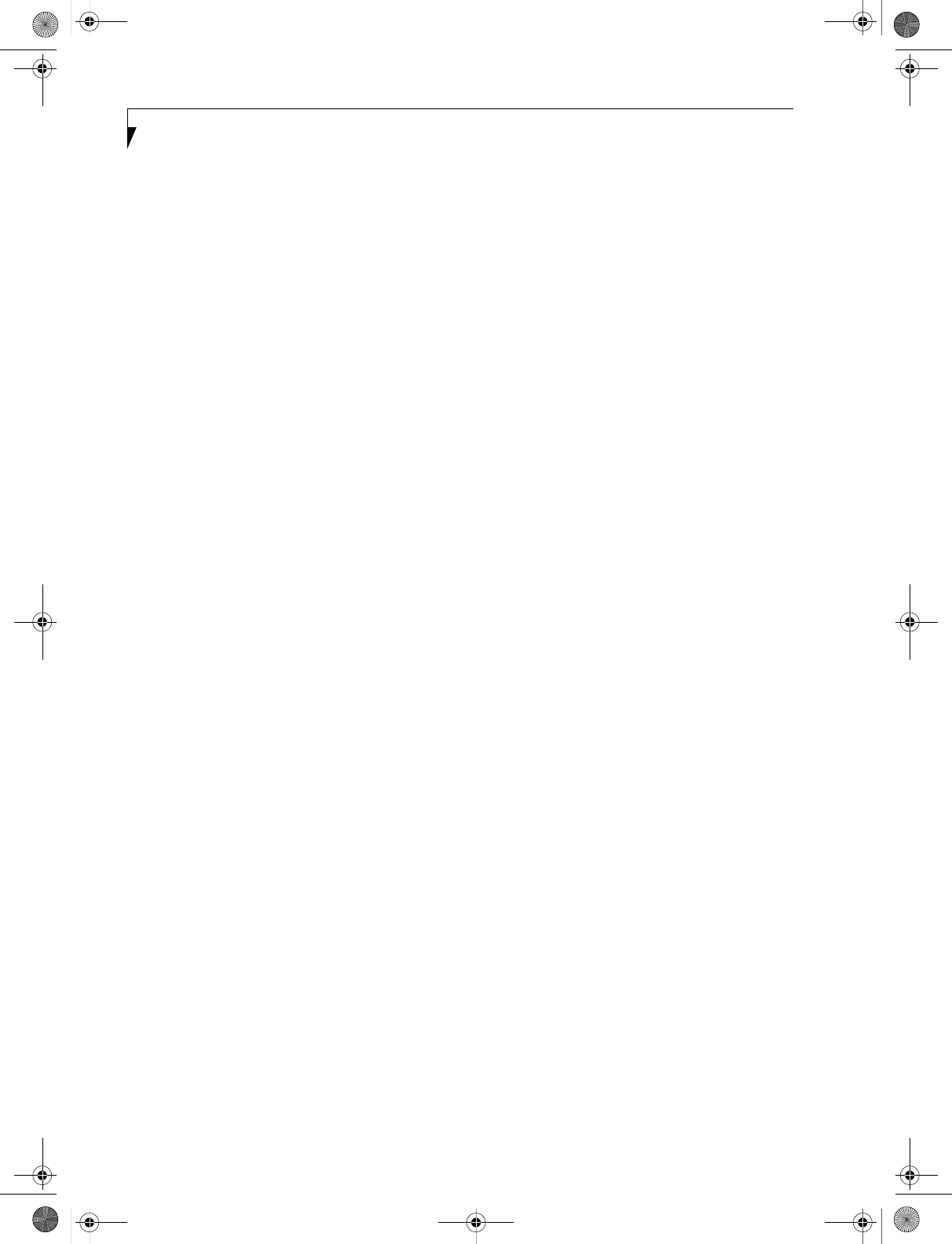
4
LifeBook T Series Tablet PC - Preface
T Series.book Page 4 Wednesday, July 28, 2004 3:35 PM

5
2
Getting to Know
Your Tablet PC
T Series.book Page 5 Wednesday, July 28, 2004 3:35 PM
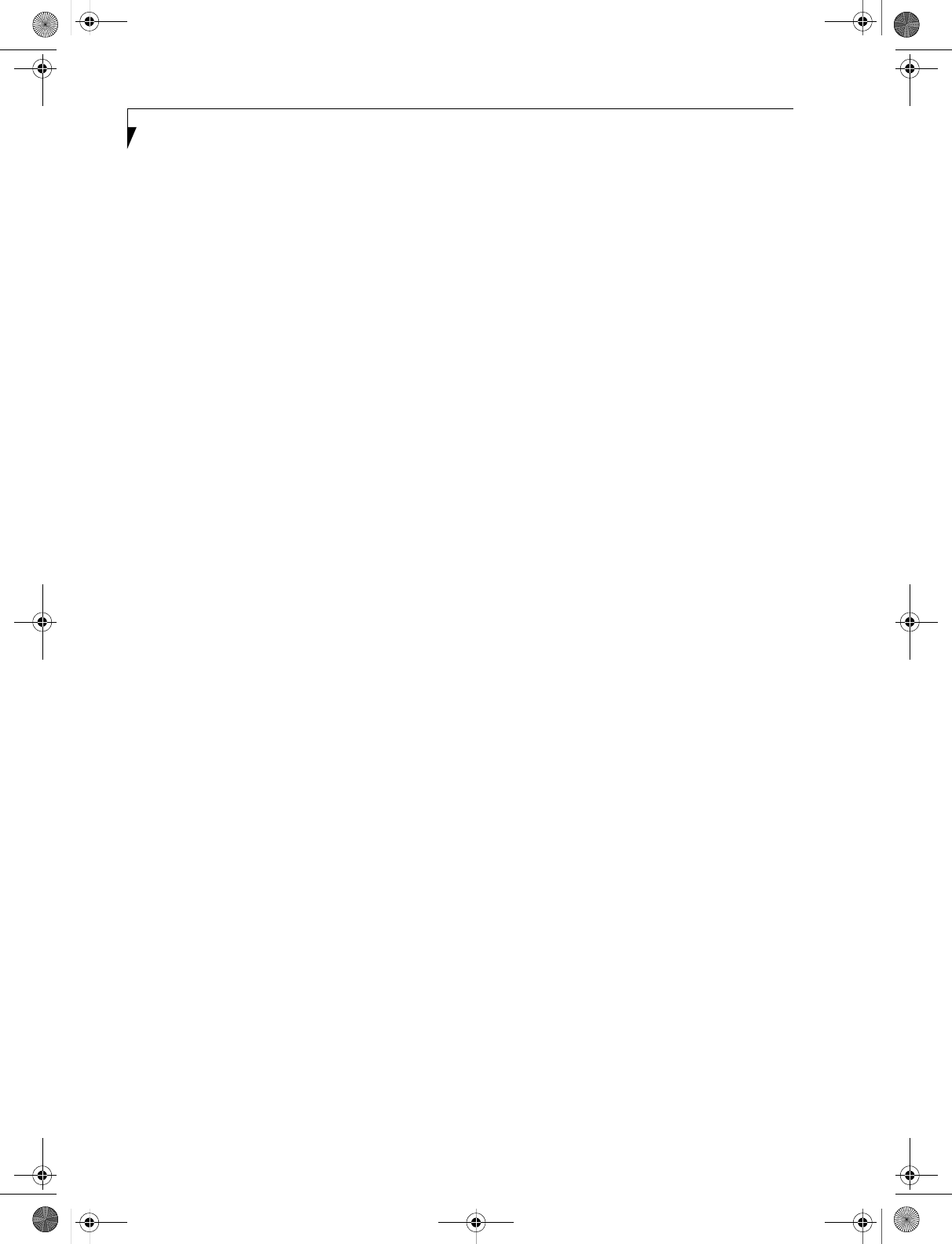
6
LifeBook T Series Tablet PC
T Series.book Page 6 Wednesday, July 28, 2004 3:35 PM
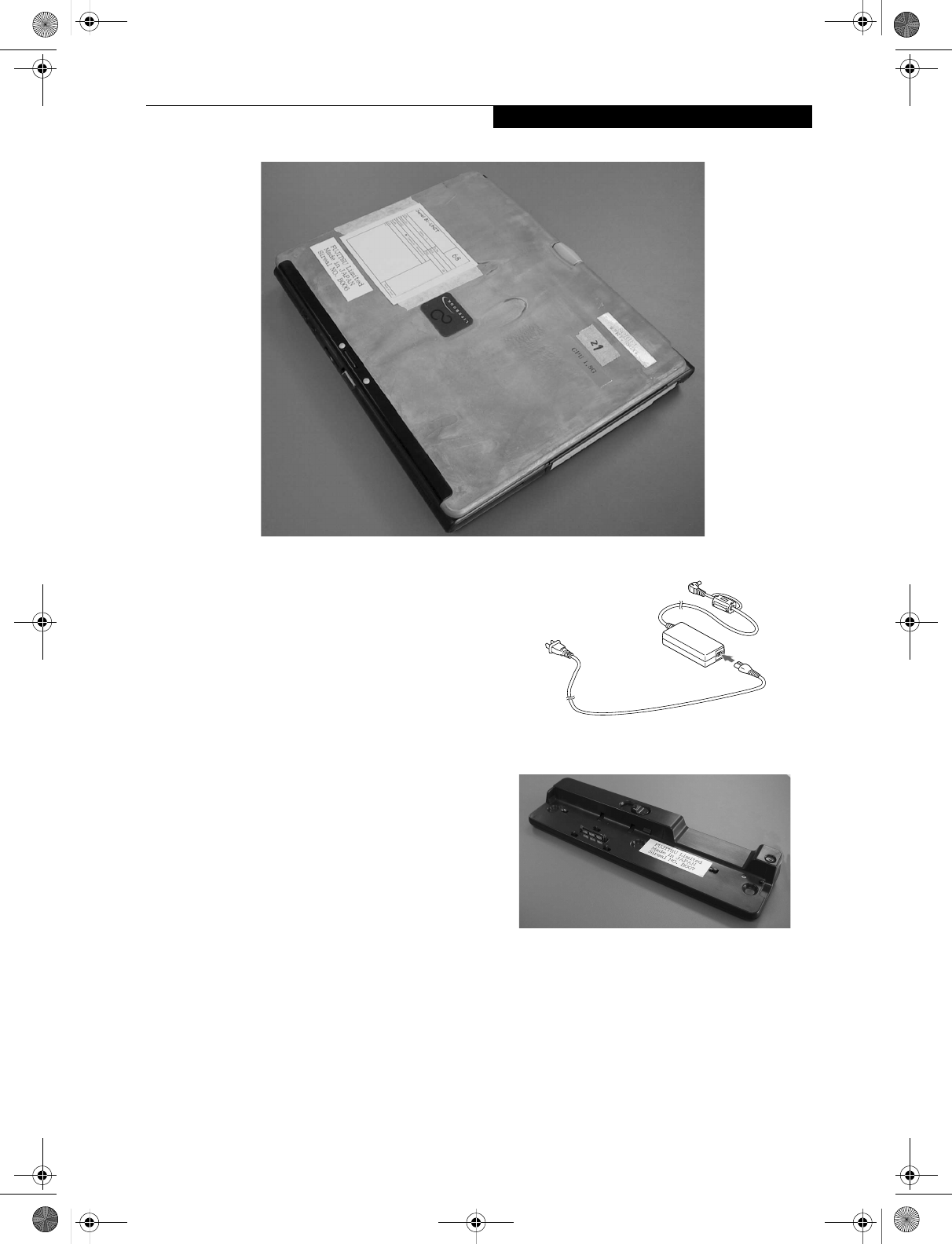
7
Getting to Know Your Tablet PC
Figure 2-1. Fujitsu LifeBook T Series Tablet PC
Overview
This section describes the components of your Fujitsu
LifeBook T Series Tablet PC. We strongly recommend
that you read it before using your Tablet PC, even if you
are already familiar with mobile computers.
UNPACKING
When you receive your LifeBook T Series Tablet PC,
unpack it carefully, and compare the parts you have
received with the items listed below.
For a pre-configured model you should have:
■LifeBook T Series Tablet PC (Figure 2-1)
■AC adapter with AC power cord (Figure 2-2)
■Phone/Modem (RJ-11) telephone cable
■Pen
■Driver and Application Restore (DAR) CD
■Getting Started Guide
■User’s Guide (this document)
■International Limited Warranty Booklet
■Certificate of Authenticity
■Lithium ion battery (pre-installed)
You may also have one or more of the following optional
devices in the box:
■Port Replicator (Figure 2-3)
■External USB Floppy Disk Drive
Figure 2-2. AC Adapter
Figure 2-3. Optional Port Replicator
TBD - NEW GRAPHIC
TBD - NEW GRAPHIC
T Series.book Page 7 Wednesday, July 28, 2004 3:35 PM
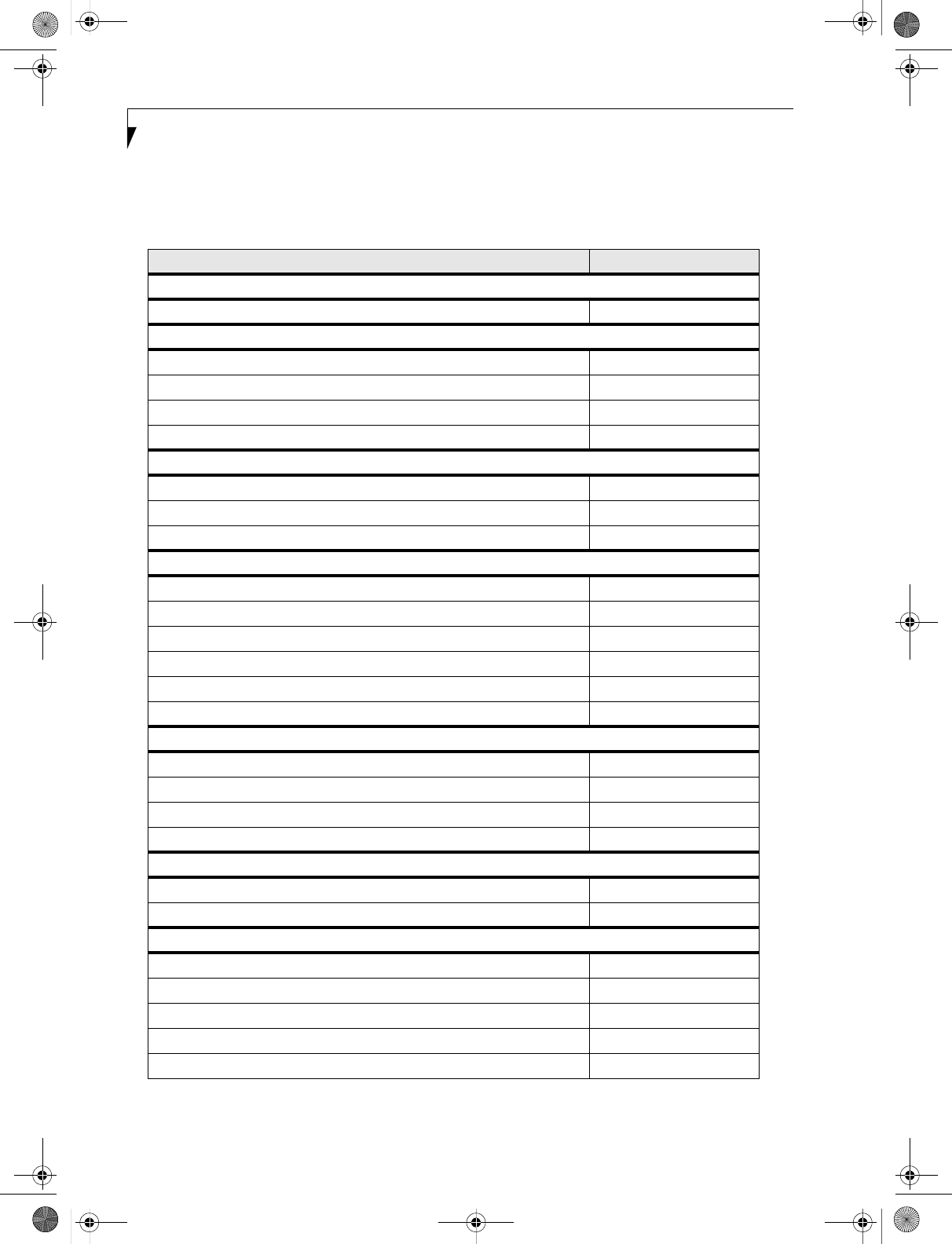
8
LifeBook T Series Tablet PC - Section 2
OPTIONAL ACCESSORIES - TBD ALL
The following optional accessories can be used with the LifeBook T Series Tablet PC. Refer to the instructions provided
with these accessories for details on their use. For the latest list of accessories available for your LifeBook T Series Tablet
PC, be sure to frequently check the Fujitsu Web site at: us.fujitsu.com/computers.
Table 2-1. Optional Accessories for LifeBook T Series Tablet PC
Peripheral/Accessory Fujitsu Part Number
Docking Options
LifeBook T Series Tablet PC port replicator FPCPR39AP
Carrying Cases
Duo Travel Bag FPCCC16
Director leather carrying case FPCCC22
Diplomat carrying case FPCCC02
Propak backpack FPCCC07
Storage Options
External USB floppy disk drive FPCFDD12
External DVD/CD-RW combo drive FPCDVR26
External CD-ROM drive FPCCD33AP
Memory
256 MB SDRAM, DDR266 FPCEM51AP
512 MB SDRAM, DDR 266 FPCEM55AP
1.0 GB SDRAM, DDR 266 FPCEM87AP
128 MB Compact Flash card FPCEMC02
256 MB Compact Flash card FPCEMC03
128 MB Secure Digital memory card FPCEMC01
Power Options
AC Adapter with US cord FPCAC23
Main battery FPCBP73AP
Auto/airline adapter FPCAA02
Battery charger FPCBC06
Input Accessories
Replacement pen set (2-pack) FPCPN11AP
USB optical mouse FPCMO08AP
Additional Accessories
Smart Card holder FPCSCH01
4-in-1 PC Card Adapter FPCPCC01
Compact Flash card adapter FPCCFA01
Notebook Guardian Lock FPCLCK02
USB 2.0 and FireWire CardBus DV Kit FPCPCC02
T Series.book Page 8 Wednesday, July 28, 2004 3:35 PM
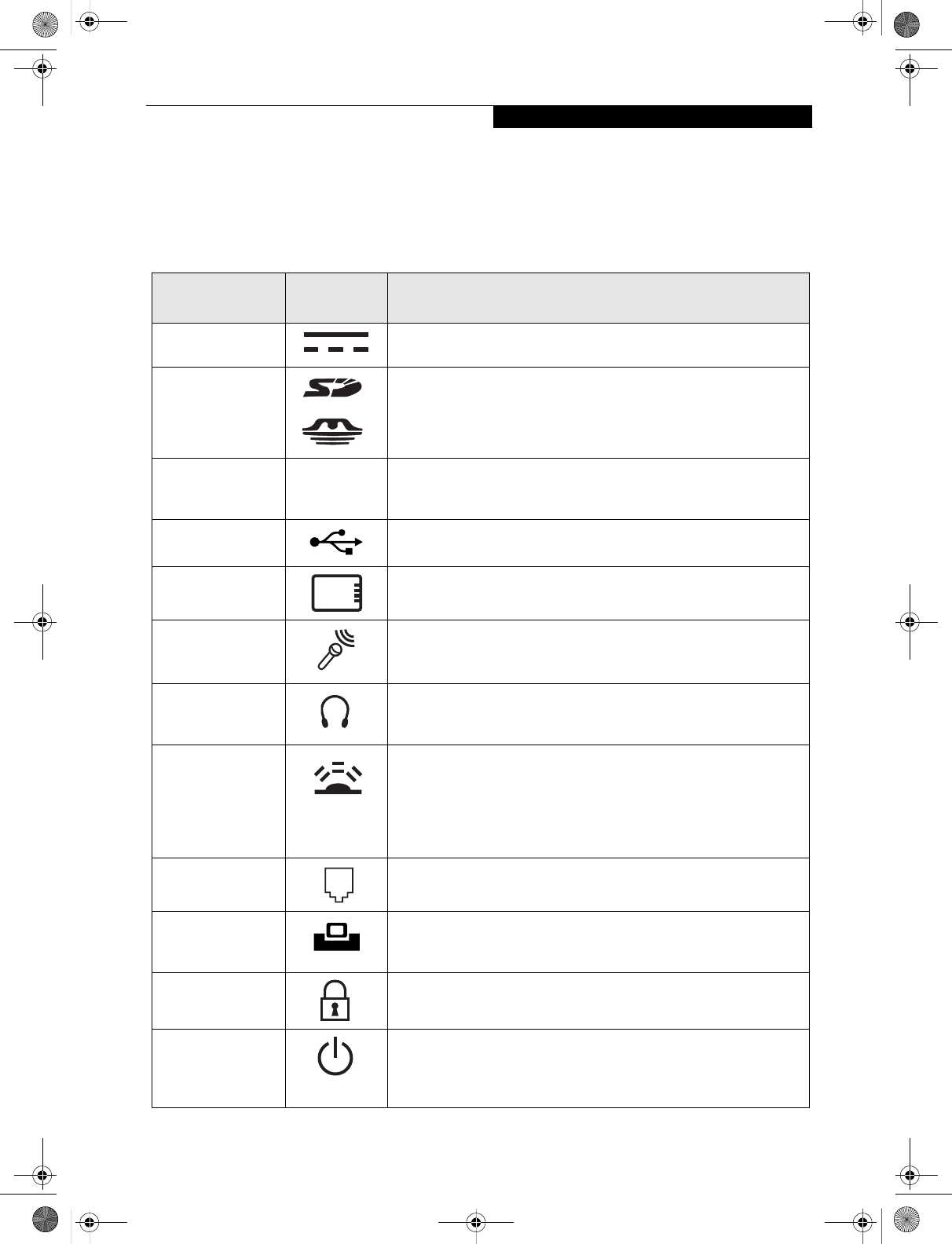
9
Getting to Know Your Tablet PC
Locating the Controls and Connectors
Connectors and peripheral interfaces on the LifeBook T
Series Tablet PC and the optional port replicator allow
you to connect a variety of devices. Specific locations are
illustrated in Figures 2-4 through 2-8. The table below
provides a short description of each icon on the Life-
Book T Series Tablet PC. Each of the icons is either
molded into or printed on the Tablet PC chassis.
Connection Tablet PC
Icon Purpose
DC in connector Connect an external power source such as the AC adapter or auto/
airline adapter.
SD/Memory
Stick Slot The Secure Digital (SD) card/Memory Stick slot allows you to install
a flash memory card for data storage. Flash memory cards allow
you to transfer data to and from a variety of different digital
devices.
Smart Card Slot The dedicated Smart Card slot allows you to install a Smart Card on
which you can store such data as medical information or electronic
"cash".
USB Port Connect Universal Serial Bus 2.0 or 1.1 compliant devices to the
Tablet PC.
PCMCIA Card slot
Install Type I, Type II, or Type III PC Cards.
Microphone jack Connect an external microphone. The internal microphone is
disabled when you plug in an external microphone.
Headphone jack Connect stereo headphones or powered external speakers. The
internal speaker is disabled when you plug in external headphones
or powered speakers.
IrDA/FIR port An infrared transceiver built into the Tablet PC allows you to
communicate with other devices that are compliant with IrDA
Standard Rev. 1.1. Effective range for infrared communication is
about 3 feet, and within 15 degrees off center. A clear line-of-sight
path must exist between the IrDA port on the computer and the
IrDA transceiver on the other device.
Modem Connect a telephone line to the internal modem using a standard
RJ-11 telephone plug.
Tablet Dock port Connect the Tablet PC port replicator or other approved docking
device. Refer to documentation accompanying the dock for more
information.
Security lock slot The security slot allows you to secure the Tablet PC using
Kensington-compatible locking devices.
Suspend/Resume
button
The Suspend/Resume button allows you to suspend Tablet PC
activity without powering off, resume your Tablet PC from suspend
mode, and power on the system when it has been shut down from
Windows.
tbd
T Series.book Page 9 Wednesday, July 28, 2004 3:35 PM
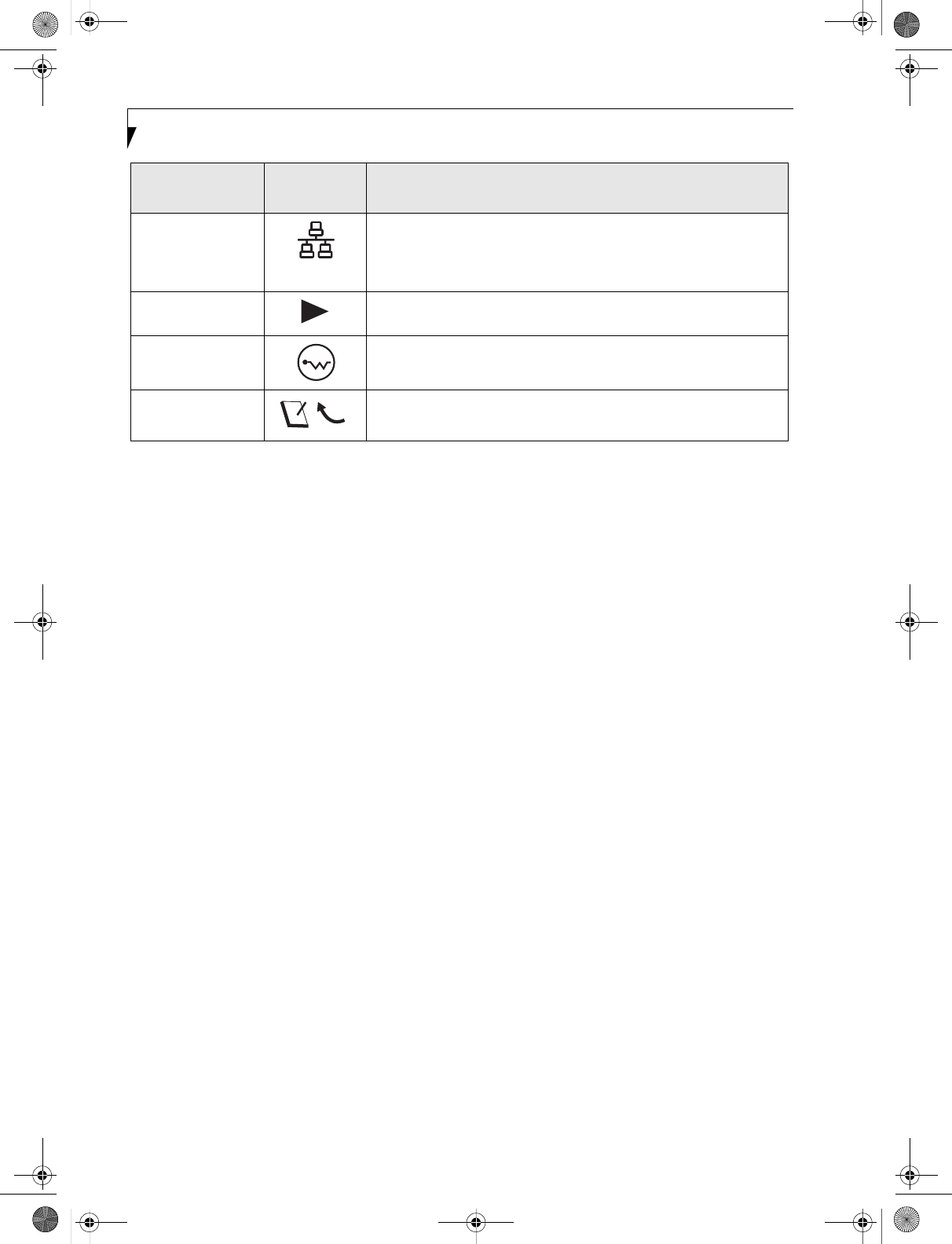
10
LifeBook T Series Tablet PC - Section 2
Table 2-2. System icons
Local Area
Network (LAN)
The LAN (RJ-45) jack is used to connect the internal Fast Ethernet
(10/100 Base-T/TX) to a Local Area Network (LAN) in your office or
home, or broadband devices such as a cable modem, DSL, or satellite
Internet.
Battery Release
Latch
The battery release latch allows you to remove the battery from
your system for storage or replacement.
Wireless LAN
On-Off Switch
The wireless LAN switch allows you to turn power to the optional
wireless LAN device on and off.
Display Rotation This icon indicates the direction in which the display should be
rotated when converting to tablet mode.
Connection Tablet PC
Icon Purpose
T Series.book Page 10 Wednesday, July 28, 2004 3:35 PM
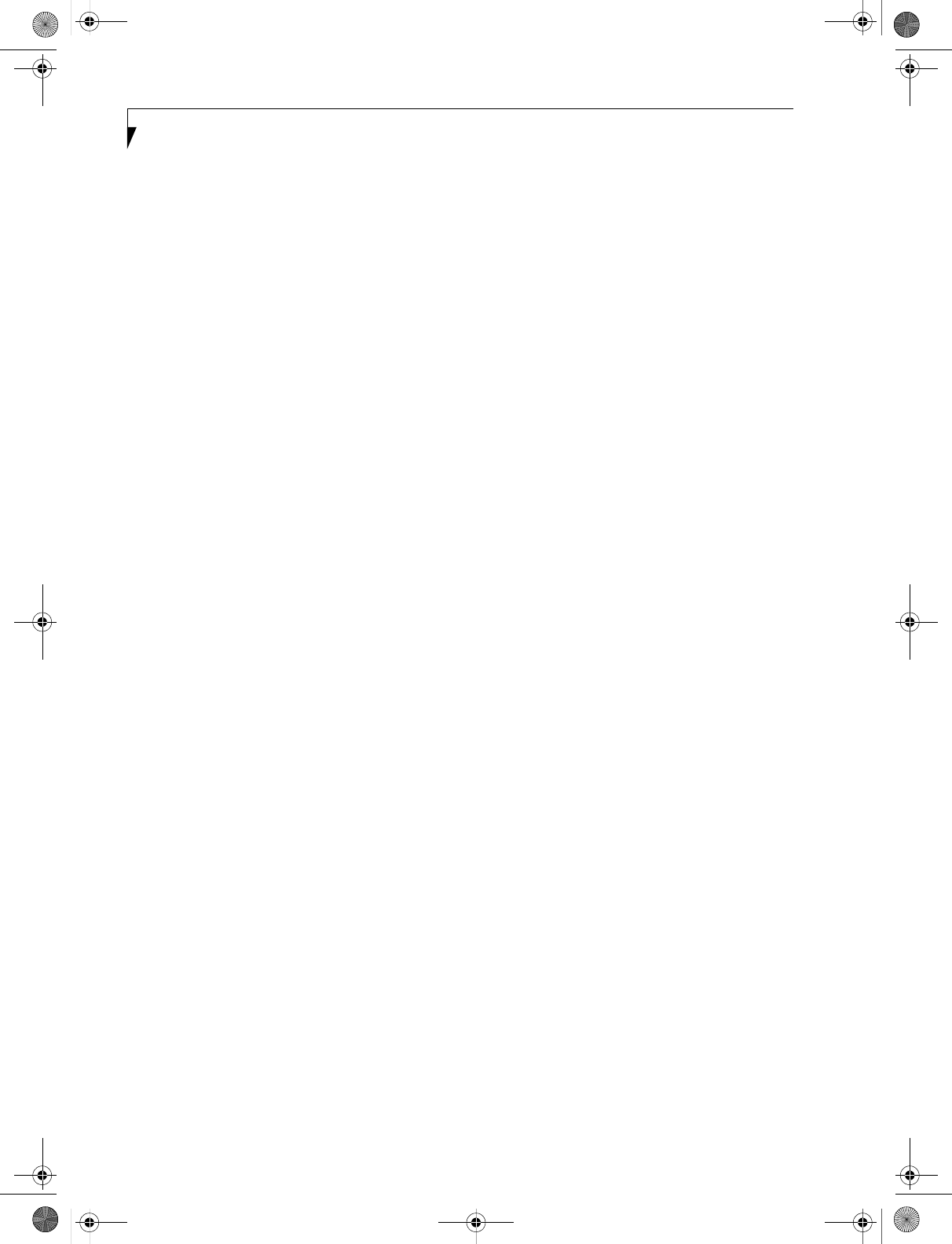
12
LifeBook T Series Tablet PC - Section 2
Dual Speakers
The dual speakers allow you to listen to stereo sound
from your system.
Suspend/Resume Button
The Suspend/Resume button allows you to suspend
Tablet PC activity without powering off, resume your
Tablet PC from standby mode, and power on your
system when it has been shut down from the Windows
operating system. See “Power On” on page 34.
Rotation Hinge
The rotation hinge allows you to transform your Tablet
PC from a notebook configuration into a tablet configu-
ration. For more information, see See “Using the System
as a Tablet” on page 17.
Headphone Jack
The headphone jack allows you to connect headphones
or powered external speakers. See “Headphone Jack” on
page 53.
Microphone Jack
The microphone jack allows you to connect an external
mono microphone. See “Microphone Jack” on page 53.
T Series.book Page 12 Wednesday, July 28, 2004 3:35 PM
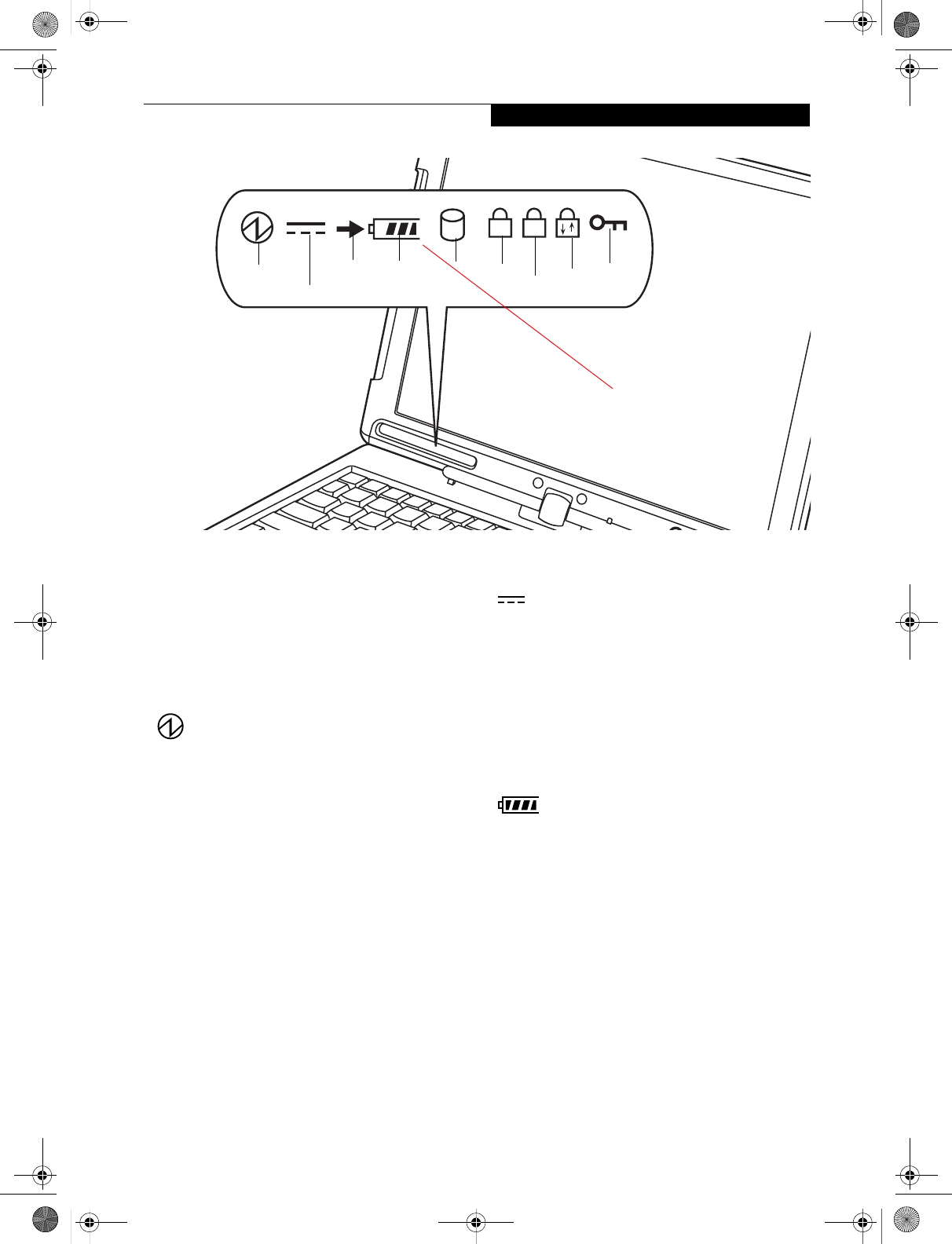
15
Getting to Know Your Tablet PC
Figure 2-9. Status Indicator Panel
Status Indicator Panel
The Status Indicator Panel displays symbols that corre-
spond to specific components of your LifeBook T Series
Tablet PC. These symbols tell you how each of those
components is operating. (Figure 2-9)
POWER INDICATOR
The Power indicator symbol states whether your system
is operational. It has several different states, each of
which tells you what mode your Tablet PC is in at that
time.
■Steady On: This means that there is power to your
Tablet PC and that it is ready for use.
■Flashing: This means that your Tablet PC is in Standby
mode.
■Steady Off: This means that your system is either in
Hibernate mode, or that your Tablet PC has been
turned off.
If you are charging your battery, the Power indicator
symbol will remain on even if your LifeBook T Series
Tablet PC is shut off. The Power indicator symbol will
also remain on if you have either adapter connected and
are shut down from Windows.
AC ADAPTER INDICATOR
The AC adapter indicator states whether your tablet is
operating from the AC adapter, the auto/airline adapter
or the batteries. This icon has two different states that
can tell you what power source your LifeBook Tablet PC
is using.
■On: This means that either of the adapters are
currently in use.
■Off: Power is only coming from the batteries, and
you do not have an adapter connected.
BATTERY LEVEL INDICATORS
The Battery Level indicators state whether or not the
Lithium ion battery is installed and how much charge is
available within the battery. (Figure 2-10)
Additionally, this indicator displays when an overcur-
rent is detected. If an overcurrent is detected, the battery
stops charging and the Battery Level indicator blinks at
the rate of once per second. To stop the indicator from
blinking, you must disconnect the power adapter.
A1
Battery
Level Hard Drive
Access
Battery
Charging NumLk
ScrLk
Security
Indicator
CapsLk
Power
AC Adapter
NEW GRAPHIC
TBD - Will there be a second battery
indicator for a modular battery?
T Series.book Page 15 Wednesday, July 28, 2004 3:35 PM
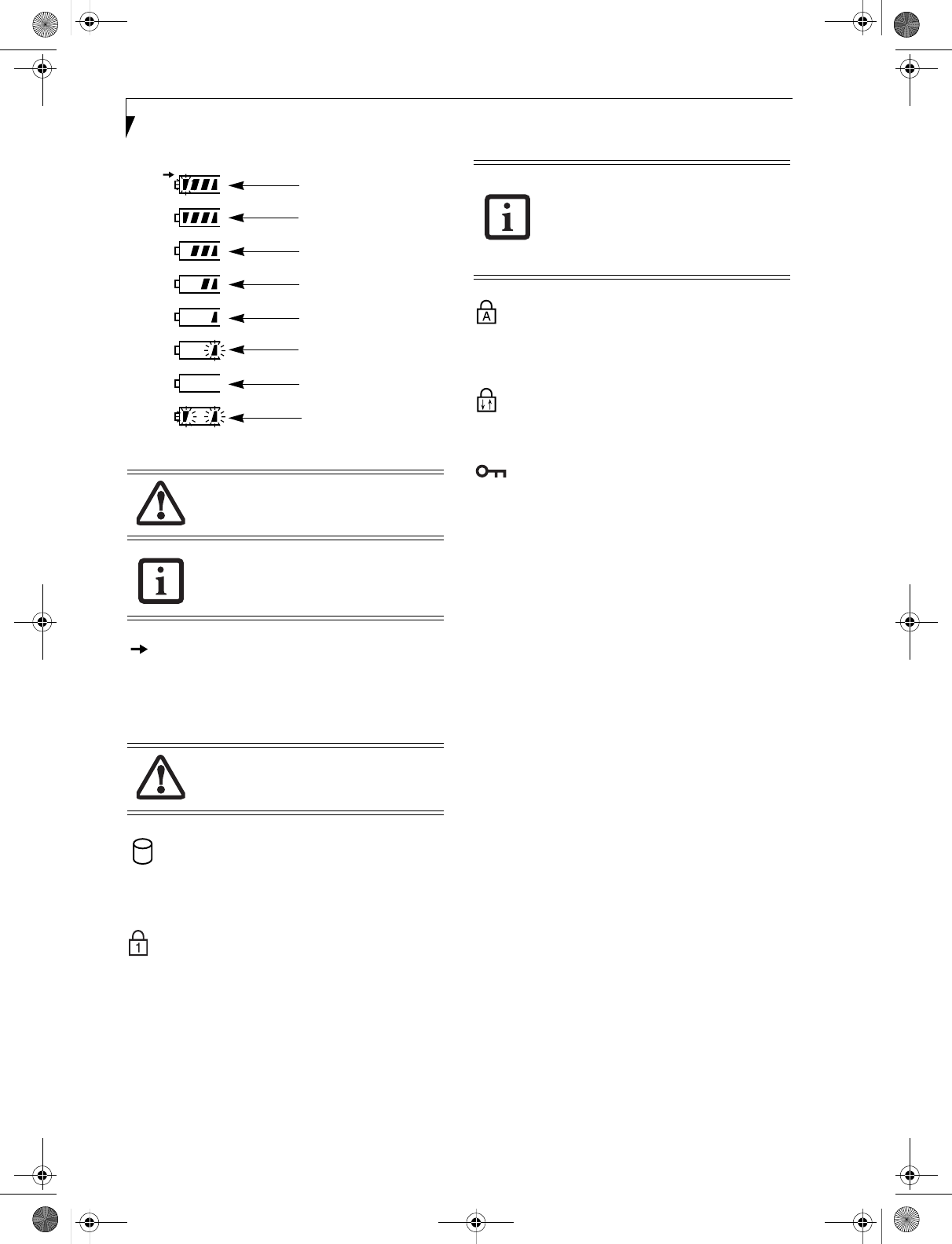
16
LifeBook T Series Tablet PC - Section Two
Figure 2-10. Battery Level Indicator
BATTERY CHARGING INDICATOR
Located to the left of the Battery Level indicator is a
small arrow symbol. This symbol states whether the
battery is charging. This indicator will flash if the battery
is too hot or cold to charge.
HARD DRIVE ACCESS INDICATOR
The Hard Drive Access indicator states whether your
internal hard drive is being accessed.
NUMLK INDICATOR
The NumLk indicator states that the integral keyboard is
set in ten-key numeric keypad mode.
If there is no battery activity and the power adapters are
not connected, the Battery Level indicators will also be
off.
CAPSLOCK INDICATOR
The CapsLock indicator states that your keyboard is set
to type in all capital letters.
SCRLK INDICATOR
The ScrLk indicator states that your scroll lock is active.
SECURITY INDICATOR
The Security Indicator flashes (if a password was set)
when the system resumes from Off or Standby modes.
You must enter the password that was set in the Security
Panel before your system will resume operation.
A shorted battery is damaged and must be
replaced. (Figure 2-10)
If there is no battery activity and the
power adapters are not connected, the
Battery Level indicators will also be off.
Batteries subjected to shocks, vibration or
extreme temperatures can be permanently
damaged.
76%–100% Charging
76%–100%
51%–75%
26%–50%
11%–25%
Low Warning <11%
Critical Low or
Dead Battery
Shorted Battery
If you are using the optional external
numerical keypad, pressing the [NumLk]
key will activate the external keypad. The
indicator will come on, however it will not
change any of the functionality of your
keyboard keys.
T Series.book Page 16 Wednesday, July 28, 2004 3:35 PM
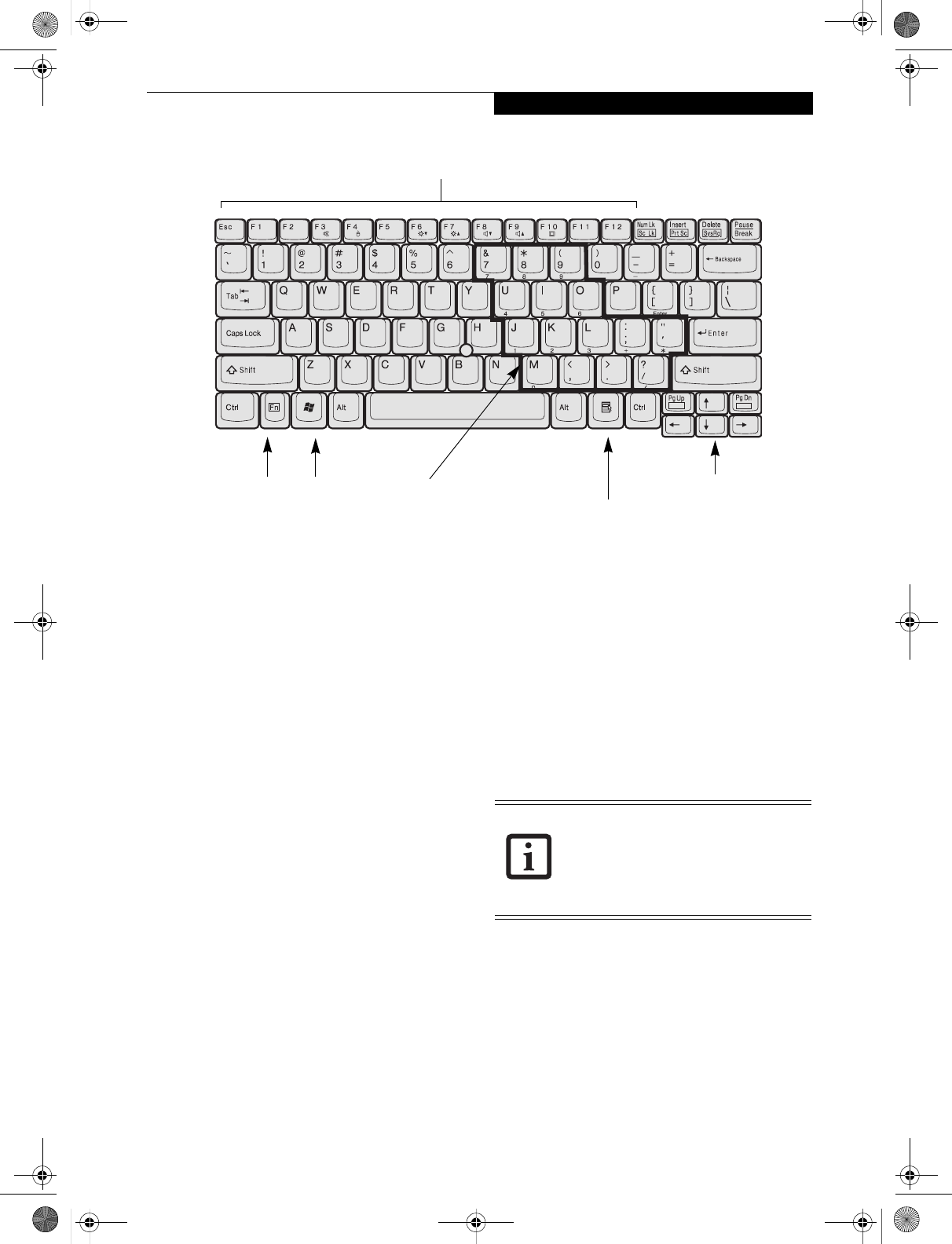
19
Getting to Know Your Tablet PC
Figure 2-17. Keyboard
Keyboard
USING THE KEYBOARD
Your LifeBook T Series Tablet PC has an integral 83-key
keyboard. The keys perform all the standard functions
of a 101-key keyboard, including the Windows keys and
other special function keys. This section describes the
following keys. (Figure 2-17)
■Numeric keypad: Your Tablet PC allows certain keys to
serve dual purposes, both as standard characters and
as numeric and mathematical keys. The ability to tog-
gle between the standard character and numerical keys
is controlled through the [NumLk] key.
■Cursor keys: Your keyboard contains four arrow
keys for moving the cursor or insertion point to the
right, left, up, or down within windows, applications
and documents.
■Function keys: The keys labeled [F1] through [F12],
are used in conjunction with the [Fn] key to produce
special actions that vary depending on what program
is running.
■Windows keys: These keys work with your Windows
operating system and function the same as the
onscreen Start menu button, or the right button on
your pointing device.
NUMERIC KEYPAD
Certain keys on the keyboard perform dual functions as
both standard character keys and numeric keypad keys.
NumLk can be activated by pressing the [NumLk] key.
Turning off the NumLk feature is done the same way.
Once this feature is activated you can enter numerals 0
through 9, perform addition ( + ), subtraction ( - ),
multiplication ( * ), or division ( / ), and enter decimal
points ( . ) using the keys designated as ten-key function
keys. The keys in the numeric keypad are marked on the
front edge of the key to indicate their secondary func-
tions. (Figure 2-17)
WINDOWS KEYS
Your LifeBook T Series Tablet PC has two Windows
keys: a Start key and an Application key. The Start key
displays the Start menu. This button functions the same
as your onscreen Start menu button. The Application
key functions the same as your right mouse button and
displays shortcut menus for the selected item. (Please
refer to your Windows documentation for additional
information regarding the Windows keys.) (Figure 2-17)
End
Home
Fn Key Start Key
Function Keys
Numeric Keypad
Application Key
Cursor Keys
(outlined with thick
black line)
If you are using the optional external
numerical keypad, pressing the [NumLk]
key will activate the external keypad. The
indicator will come on, however it will not
change any of the functionality of your
keyboard keys.
T Series.book Page 19 Wednesday, July 28, 2004 3:35 PM
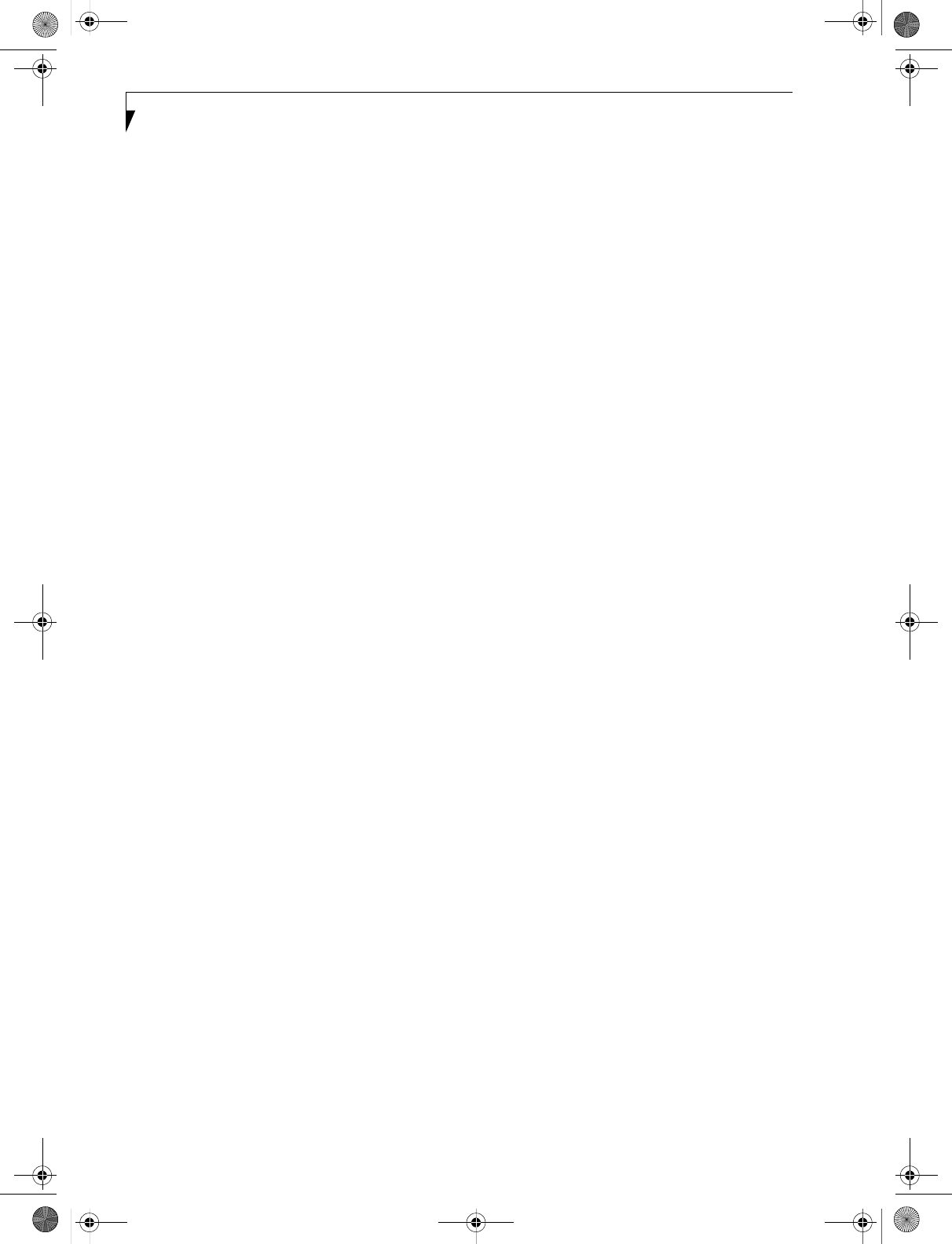
20
LifeBook T Series Tablet PC - Section Two
CURSOR KEYS
The cursor keys are the four arrow keys on the keyboard
which allow you to move the cursor up, down, left, and
right in applications. In programs such as Windows
Explorer, it moves the “focus” (selects the next item up,
down, left, or right). (Figure 2-17)
FUNCTION KEYS
Your Tablet PC has 12 function keys, F1 through F12.
The functions assigned to these keys differ for each
application. You should refer to your software documen-
tation to find out how these keys are used.
(Figure 2-17)
[Fn] Key
The [Fn] key provides extended functions for the
Tablet PC and is always used in conjunction with
another key.
■[Fn+F3]: Pressing [F3] while holding [Fn] will toggle
the Audio Mute on and off.
■[Fn+F4]: Pressing [F4] while holding [Fn] will toggle
the built-in pointing device on and off. Note that the
[Fn+F4] combination only works if Manual Setting is
selected in the BIOS. (See “Entering the BIOS Setup
Utility” on page 34)
■[Fn +F5]: Pressing [F5] while holding [Fn] allows
you to toggle between video compensation and no
compensation. (Video compensation controls spacing
on the display. When it is enabled, displays with less
than 1024 x 768 or 800 x 600 pixel resolution will still
cover the entire screen.)
■[Fn+F6]: Pressing [F6] repeatedly while holding [Fn]
will lower the brightness of your display. Note that
adjusting the brightness using the keyboard changes
the system setting.
■[Fn+F7]: Pressing [F7] repeatedly while holding [Fn]
will increase the brightness of the display.
■[Fn+F8]: Pressing [F8] repeatedly while holding [Fn]
will decrease the volume of your Tablet PC.
■[Fn+F9]: Pressing [F9] repeatedly while holding [Fn]
will increase the volume of your Tablet PC.
■[Fn+F10]: Pressing [F10] while holding [Fn] allows
you to change your selection of where to send your
display video. Each time you press the combination
of keys you will step to the next choice. The choices,
in order, are: built-in display panel only, both built-in
display panel, and external monitor or external moni-
tor only.
T Series.book Page 20 Wednesday, July 28, 2004 3:35 PM
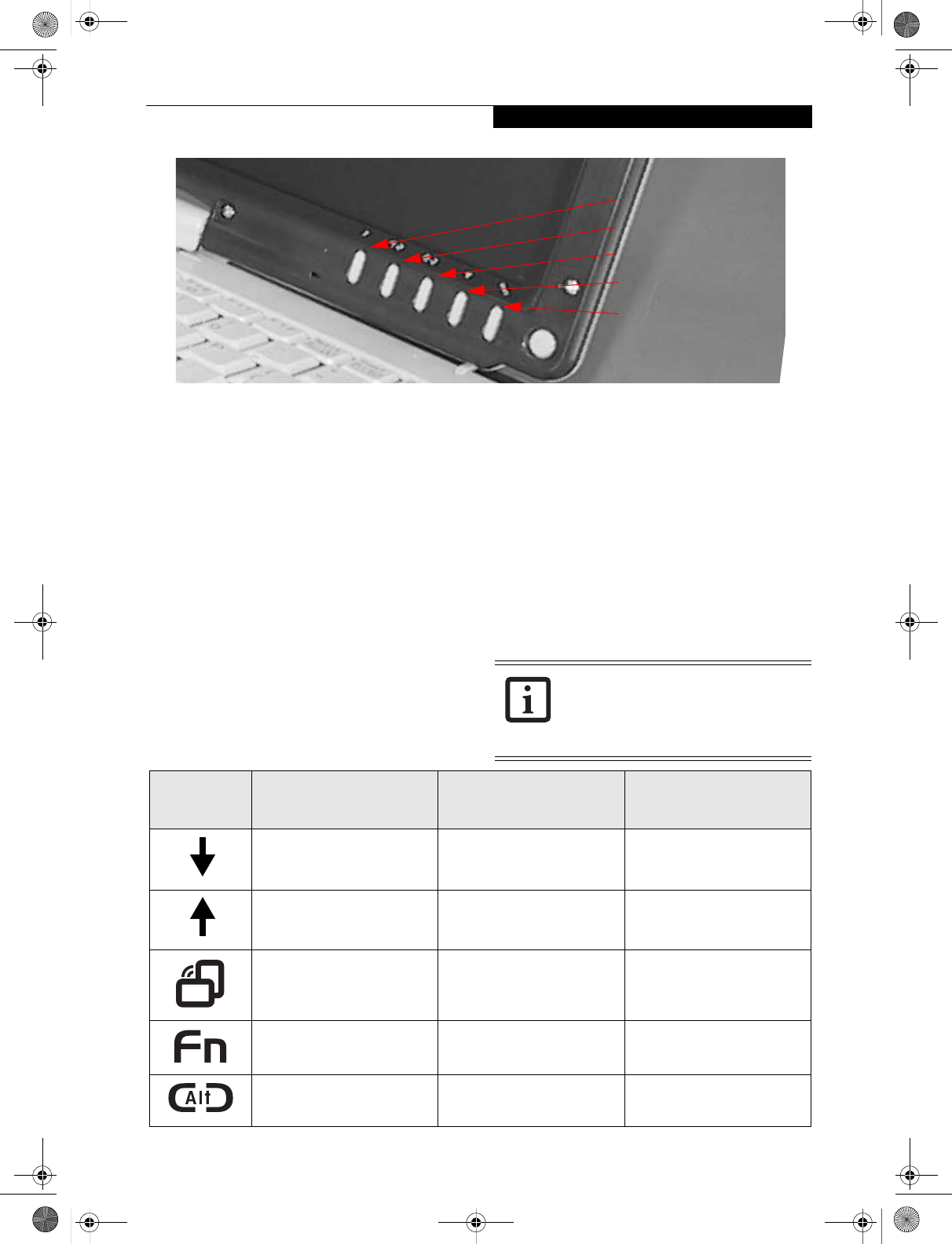
21
Getting to Know Your Tablet PC
Figure 2-18. LifeBook T Series Tablet PC Security/Tablet PC Buttons
LifeBook Security/
Tablet PC Buttons
A unique feature of your LifeBook T Series Tablet PC is
the array of Security and Tablet PC buttons. These
buttons allow you to secure your Tablet PC from
unauthorized use and to launch specific applications
with the touch of a button.
If the security system is activated, upon starting your
Tablet PC or resuming from Standby, Hibernate, or shut-
down mode the security system will require you to enter
a password code using the security buttons. After you
enter the correct password, your Tablet PC will resume
operation.
The five security/Tablet PC buttons are located on the
bottom right-hand side of the display when it is config-
ured to be used as a notebook. (Figure 2-18)
Security functions: All five buttons are used when
implementing security functions. Four of the buttons
are used to enter the password, and the fifth is used as an
Enter button. See the right-hand column of Table 2-3.
Tablet PC functions: All five of the buttons have
primary functions. Four of the buttons have secondary
functions when used as application buttons. The
secondary functions are activated by pressing the Func-
tion (Fn) button while pressing the application button.
See Table 2-3 for specific functions. The secondary func-
tions of the Application A and B buttons can be changed
to launch any application. See “Changing Tablet PC
Button Functions” on page 22
Table 2-3. Security/Tablet PC Button Functions
(1) Application A Button
(3) Button 3
(2) Application B Button
(4) Button 4
Enter Button
NEW GRAPHIC
When the system is logging on or when it is
locked (i.e., when you have the Logon or
Computer Locked window showing on your
desktop), the A and B buttons act as [Tab]
and [Enter] keys, respectively.
Button Icon Primary Function Secondary Function
(Fn + Button)
Security Panel Function
(Pre-boot and resuming
from suspend)
Page Down User-defined Application A
(Default = Calculator) Security Button 1
Page Up User-Defined Application B
(Default = MS Journal) Security Button 2
Screen Rotation VGA-Out Security Button 3
Secondary Function
Selection Fujitsu Menu Utility Security Button 4
Ctl+Alt+Del Button None Security Enter Button
T Series.book Page 21 Wednesday, July 28, 2004 3:35 PM
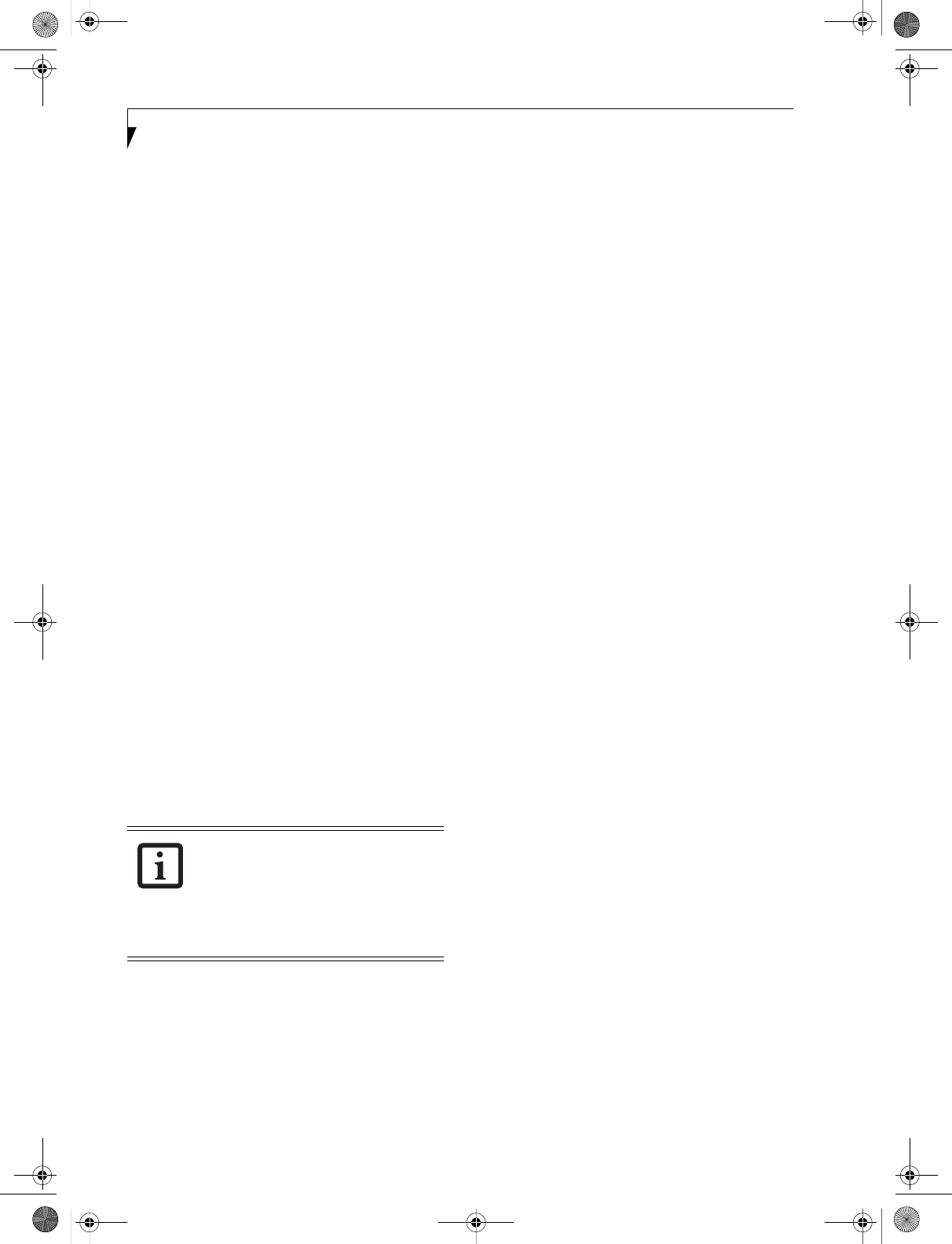
22
LifeBook T Series Tablet PC - Section Two
Page Down / Application A Button
When you press the Page Down button when the system
is running, each press of the button will scroll the screen
down one frame. This allows you to navigate quickly
through large documents.
When you press the Fn button while you press then
release the Page Down/Application A button, you will
automatically start whichever program is assigned to the
button. The default application for this button is Calcu-
lator.
See “Changing Tablet PC Button Functions” on page 22
to select a different application for this button.
Page Up / Application B Button
When you press the Page Up button when the system is
running, each press of the button will scroll the screen
up one frame. This allows you to navigate quickly
through large documents.
When you press the Fn button while you press then
release the Page Up/Application A button, you will auto-
matically start whichever program is assigned to the
button. The default application for this button is
Microsoft Journal.
See “Changing Tablet PC Button Functions” on page 22
to select a different application for this button.
Screen Rotation / VGA-Out Button
The screen rotation feature would normally be used only
when the system is configured as a tablet. When you
would like to use the tablet as an eBook, for example,
you would use the portrait orientation; when accessing
spreadsheets or using the system as a notebook, you
would more typically use landscape orientation.
When the system is changed to tablet configuration, the
orientation automatically changes to portrait mode by
default.
When you press the Screen Rotation / VGA-Out button,
the system screen orientation changes from portrait
(vertical) to landscape (horizontal) or from landscape to
portrait.
Function / Fujitsu Menu Utility Button
The Function button works in conjunction with the
other application buttons to provide additional func-
tionality for the buttons. Refer to specific details above.
Pressing the Fn button twice in succession causes the
Fujitsu Menu Utility to appear on your screen, allowing
you to modify certain system settings.
Ctl+Alt+Del Button
Pressing and holding the Ctl-Alt-Del button for up to
750 msecs launches the Logon screen or the Windows
Task Manager (if the system hasn’t yet been configured).
CHANGING TABLET PC BUTTON FUNCTIONS
The Application A and B buttons can be changed to
launch a program or perform an action you select. By
default, the Application A button launches the Calcu-
lator, and the Application B button launches MS
Journal.
To launch different applications or cause the Application
A or B buttons to perform a specific action:
1. Double-click on the Tablet and Pen Settings icon in
the Control Panel.
2. Select the Tablet Buttons tab and select the button
you would like to change from the list.
3. Click [Change] and open the drop down list in the
Action: field.
4. Select the action you would like the button to
perform. If you want to launch a program, click on
Launch an Application then browse to the location
of the program.
5. Click [OK], then click [OK] again. The buttons will
now perform the actions you have assigned to them.
SETTING UP LIFEBOOK SECURITY PANEL
When you receive your Tablet PC, the security panel
application is pre-installed without any passwords. The
following sections provide detailed information on your
security panel, how to set, change or remove passwords.
Numbered Buttons
Use these buttons to enter your password.(Figure 2-18)
Enter Button
After entering the button strokes, push this button to
enter the password into the Tablet PC. (Figure 2-18)
PASSWORDS
The user and supervisor password may be set on this
Tablet PC. A supervisor password is typically the same
for all Tablet PC’s and notebooks in a work group, office,
or company to allow for system management. Individual
computers in a group environment should not use a
common password. A password consists of one to five
button strokes plus the enter button. A valid stroke
consists of pushing one or up to four buttons simulta-
neously.
The screen orientation default can be
changed by going to the Control Panel and
double-clicking on the Fujitsu Display
Control icon and selecting the desired
defaults from the Display Orientation
section. After changing the defaults, click
[OK].
T Series.book Page 22 Wednesday, July 28, 2004 3:35 PM